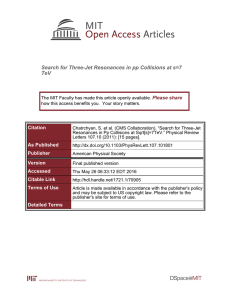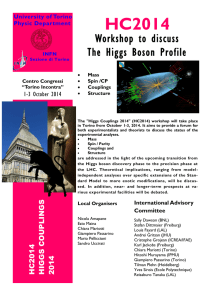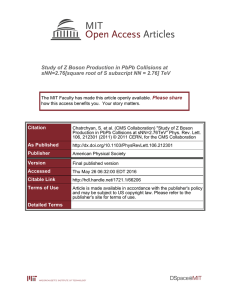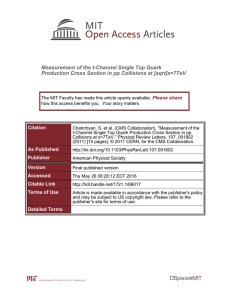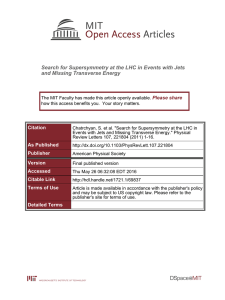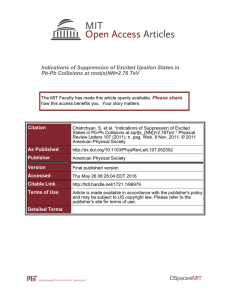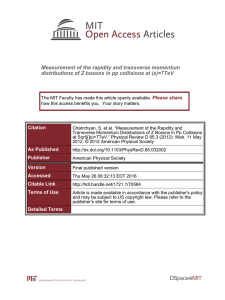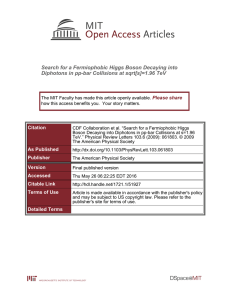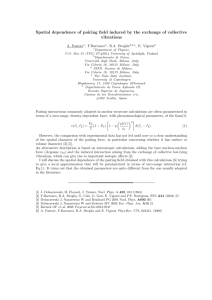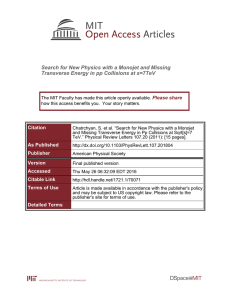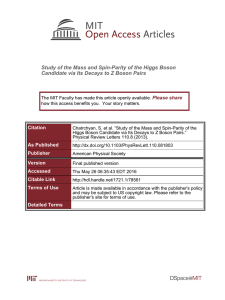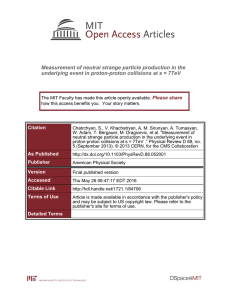Search for the Standard Model Higgs Boson in the Decay
advertisement
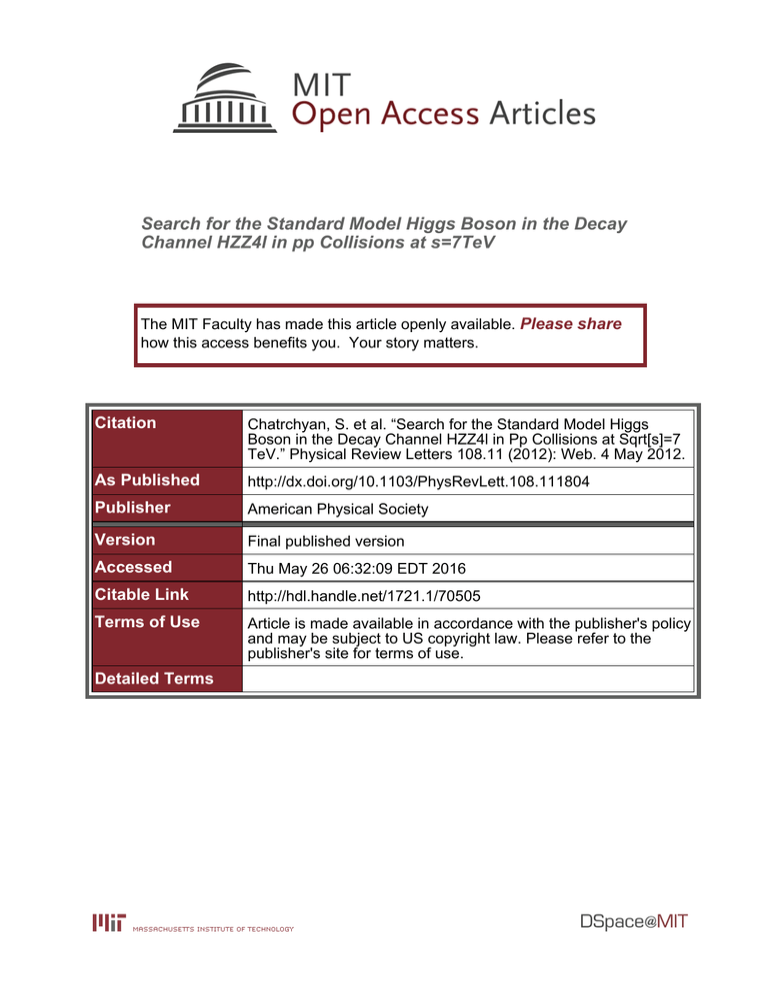
Search for the Standard Model Higgs Boson in the Decay Channel HZZ4l in pp Collisions at s=7TeV The MIT Faculty has made this article openly available. Please share how this access benefits you. Your story matters. Citation Chatrchyan, S. et al. “Search for the Standard Model Higgs Boson in the Decay Channel HZZ4l in Pp Collisions at Sqrt[s]=7 TeV.” Physical Review Letters 108.11 (2012): Web. 4 May 2012. As Published http://dx.doi.org/10.1103/PhysRevLett.108.111804 Publisher American Physical Society Version Final published version Accessed Thu May 26 06:32:09 EDT 2016 Citable Link http://hdl.handle.net/1721.1/70505 Terms of Use Article is made available in accordance with the publisher's policy and may be subject to US copyright law. Please refer to the publisher's site for terms of use. Detailed Terms Selected for a Viewpoint in Physics PHYSICAL REVIEW LETTERS PRL 108, 111804 (2012) week ending 16 MARCH 2012 Search for the Standard Model Higgs Bosonpin ffiffiffi the Decay Channel H ! ZZ ! 4l in pp Collisions at s ¼ 7 TeV S. Chatrchyan et al.* (CMS Collaboration) (Received 9 February 2012; published 13 March 2012) A search for a Higgs boson in the four-lepton decay channel H ! ZZ, with each Z boson decaying to an electron or muon pair, is reported. The search covers Higgs boson mass hypotheses in the range of 110 < mH < 600 GeV. The analysis uses data corresponding to an integrated luminosity of 4:7 fb1 pffiffiffi recorded by the CMS detector in pp collisions at s ¼ 7 TeV from the LHC. Seventy-two events are observed with four-lepton invariant mass m4‘ > 100 GeV (with 13 below 160 GeV), while 67:1 6:0 (9:5 1:3) events are expected from background. The four-lepton mass distribution is consistent with the expectation of standard model background production of ZZ pairs. Upper limits at 95% confidence level exclude the standard model Higgs boson in the ranges of 134–158 GeV, 180–305 GeV, and 340–465 GeV. Small excesses of events are observed around masses of 119, 126, and 320 GeV, making the observed limits weaker than expected in the absence of a signal. DOI: 10.1103/PhysRevLett.108.111804 PACS numbers: 14.80.Bn, 12.15.Ji, 13.38.Dg, 13.85.Qk The standard model (SM) of electroweak interactions [1–3] relies on a scalar particle, the Higgs boson, associated with the field responsible for the spontaneous electroweak symmetry breaking [4–9]. The existence of the Higgs boson has yet to be established experimentally, while its mass, mH , is not fixed by the theory. Direct searches for the SM Higgs boson at the LEP eþ e collider and the Tevatron pp collider have led, respectively, to a lower mass bound of mH > 114:4 GeV [10], and to an exclusion in the range of 162–166 GeV [11], at 95% C.L. Indirect constraints from precision measurements favor the mass range of mH < 158 GeV [12,13] at 95% C.L. The inclusive Higgs boson production followed by the decay H ! ZZ is expected to be one of the main discovery channels at the CERN proton-proton (pp) Large Hadron Collider (LHC) for a wide range of mH values. Using the H ! ZZ and the H ! WW decay channels, the ATLAS collaboration has excluded at 95% C.L. the mass ranges of 145–206 GeV, 214–224 GeV, and 340–450 GeV [14–16]. In this Letter, an inclusive search in the four-lepton decay channel, H ! ZZ ! ‘þ ‘ ‘0þ ‘0 with ‘, ‘0 ¼ e or , abbreviated as H ! 4‘, is presented. The analysis is designed for a Higgs boson in the mass range of 110 < m pffiffiHffi < 600 GeV. It uses pp data from the LHC collected at s ¼ 7 TeV by the Compact Muon Solenoid (CMS) experiment during 2010 and 2011. The data correspond to an integrated luminosity of 4:7 fb1 . The search relies solely on the measurement of leptons, and the analysis achieves *Full author list given at the end of the article. Published by the American Physical Society under the terms of the Creative Commons Attribution 3.0 License. Further distribution of this work must maintain attribution to the author(s) and the published article’s title, journal citation, and DOI. 0031-9007=12=108(11)=111804(17) high lepton reconstruction, identification, and isolation efficiencies for a ZZ ! 4‘ system composed of two pairs of same-flavor and opposite-charge isolated leptons, eþ e or þ , in the measurement range of m4‘ > 100 GeV. One or both of the Z bosons can be off-shell. The background sources include an irreducible four-lepton contribution from direct ZZ (or Z ) production via qq annihilation and gg fusion. Reducible contributions arise from Zbb and tt where the final states contain two isolated leptons and two b jets producing secondary leptons. Additional background of instrumental nature arises from Z þ jets events where jets are misidentified as leptons. Particles produced in the pp collisions are detected in the pseudorapidity range of jj < 5, where ¼ ln tanð=2Þ and is the polar angle with respect to the direction of the proton beam. The CMS detector comprises a superconducting solenoid, providing a uniform magnetic field of 3.8 T in the bore, equipped with silicon pixel and strip tracking systems (jj < 2:5) surrounded by a lead tungstate crystal electromagnetic calorimeter (ECAL) and a brass-scintillator hadronic calorimeter (HCAL) (jj < 3:0). A steel and quartz-fiber Cherenkov calorimeter extends the coverage (jj < 5). The steel return yoke outside the solenoid is instrumented with gas detectors used to identify muons (jj < 2:4). A detailed description of the detector is given in Ref. [17]. Monte Carlo (MC) samples for the SM Higgs boson signal and for background processes are used to optimize the event selection and to evaluate the acceptance and systematic uncertainties. The Higgs boson signals from gluon-fusion (gg ! H), and vector-boson fusion (qq ! qqH), are generated with POWHEG [18] at next-toleading order (NLO) and a dedicated generator from Ref. [19]. Additional samples of, WH, ZH, and ttH events are generated with PYTHIA [20]. Events at generator level 111804-1 Ó 2012 CERN, for the CMS Collaboration PRL 108, 111804 (2012) PHYSICAL REVIEW LETTERS are reweighted according to the total cross section ðpp ! HÞ, which contains contributions from gluon fusion up to next-to-next-to-leading order (NNLO) and next-to-next-to-leading log taken from Refs. [21–32] and from the weak-boson fusion contribution computed at NNLO in Refs. [24,33–37]. The total cross section is scaled by the branching fraction BðH ! 4‘Þ calculated with PROPHECY4F which includes NLO QCD and electroweak corrections and all interference effects at NLO [24,38–41], in particular, effects specific to the 4e and 4 channels. The SM background contribution from ZZ production via qq is generated at NLO with POWHEG, while other diboson processes (WW, WZ) are generated with PYTHIA with cross sections rescaled to NLO predictions. The gg ! ZZ contribution is generated with GG2ZZ [42]. Zcc, Z, and Z þ light jets samples are generThe Zbb, ated with MADGRAPH [43] with cross sections rescaled to NNLO prediction for inclusive Z production. The tt events are generated at NLO with POWHEG. The generation takes into account the internal initial state and final state radiation effects which can lead to the presence of additional hard photons in an event. For leading-order generators, the default set of parton distribution functions (PDF) used to produce these samples is CTEQ6L [44], while CT10 [45] is used for NLO generators. All generated samples are interfaced with PYTHIA. All events are processed through a detailed simulation of the CMS detector based on GEANT4 [46] and are reconstructed with the same algorithms that are used for data. Collision events are selected by the trigger system that requires the presence of a pair of electrons (a pair of muons) with transverse energy (transverse momenta) for the first and second lepton above 17 and 8 GeV, respectively. The trigger efficiency within the acceptance of this analysis is greater than 99% for signal in the 4e and 4 channels, and rises from about 97.5% at mH ¼ 120 GeV to above 99% at mH > 140 GeV in the 2e2 channel, within the acceptance of this analysis. Electrons are reconstructed within the geometrical acceptance, je j < 2:5, and with peT > 7 GeV, by combining information from the ECAL and inner tracker [47,48]. Electron identification selection requirements rely on electromagnetic shower-shape observables and on observables combining tracker and calorimetry information. The selection criteria depend on peT , je j, and on a categorization according to observables sensitive to the amount of bremsstrahlung emitted along the trajectory in the inner tracker. Muons are reconstructed [49] within j j < 2:4 and p T > 5 GeV, using information from both the inner tracker and the muon spectrometer. The inner track is required to be composed of more than 10 tracker-layer hits [17] to ensure a precise measurement of the momentum. The efficiencies are measured in data, using a tag-and-probe technique [50] based on an inclusive sample of Z events. The measurements are performed in several ranges in p‘T and jj. The week ending 16 MARCH 2012 product of reconstruction and identification efficiencies for electrons in the ECAL barrel (endcaps) varies from about 68% (62%) for 7 < peT < 10 GeV to 82% (74%) at peT ’ 10 GeV, and reaches 90% (89%) for peT ’ 20. It drops to about 85% in the transition region, 1:44 < jj < 1:57, between the ECAL barrel and endcaps. The muons are reconstructed and identified with efficiencies above 98%. Lepton candidates are defined with a loose constraint on their isolation, by requiring the sum of the transverse momenta of tracks i within a cone around qffiffiffiffiffiffiffiffiffiffiffiffiffiffiffiffiffiffiffiffiffiffiffiffiffiffiffiffiffiffiffiffiffiffiffiffiffiffiffiffiffiffiffiffiffiffiffiffiffiffiffiffi the lepton ‘ of R ¼ ð‘ i Þ2 þ ð‘ i Þ2 < 0:3, P where is the azimuthal angle, to have i piT;track =p‘T < 0:7. The lepton isolation efficiency for identified leptons with this very loose definition of isolation is found to be greater than 99%. We first require a Z candidate formed with a pair of lepton candidates satisfying 50 < m1;2 < 120 GeV, p‘T1 > 20 GeV, and p‘T2 > 10 GeV. The pT thresholds ensure that the leptons are on the high-efficiency plateau for the trigger. The lepton pair is required to be well isolated using a combination of the tracker, ECAL, and HCAL information. The sum of the combined relative isolation Riso for the two leptons is required to satisfy R‘iso1 þ R‘iso2 < 0:35, where P P for each lepton, Riso ¼ ð1=p‘T Þ ð i piT;track þ j EjT;ECAL þ P k k ET;HCAL Þ, with sums running over the charged tracks i, and the ET from energy deposits in cells j and k of the ECAL and HCAL within a cone of radius R < 0:3, respectively. The footprint of the lepton object (a measured track for muons, or a combination of a track and a cluster of ECAL energy deposits for electrons) is removed from the isolation sum. The combined isolation efficiencies measured with data using the tag-and-probe technique are found to be >99% for muons and between 94% and 99% for electrons. The isolation is made largely insensitive to the number of overlapping pp interactions by correcting for the average energy flow [51] per unit area measured as a function of the number of primary vertices. The ratio of the efficiencies measured with data and with simulated Z ! ‘‘ events is found to be consistent with unity. The significance of the signed impact parameter (SIP) of each lepton relative to the event vertex, SIP3D ¼ IPIP , where IP is the impact parameter in three dimensions and IP the associated uncertainty, is required to satisfy jSIP3D j < 4. The ‘þ ‘ pair with reconstructed mass closest to the nominal Z boson mass is retained and denoted Z1 . The Z1 þ X data set thus defined is used below to estimate the ZZ rates. In the next step, a subset of events is identified with at least a third lepton candidate. The Z1 þ ‘ events are used to measure misidentified lepton rates. A subset of events with at least a fourth lepton candidate of any flavor or charge is then identified. Together, the Z1 þ ‘ and Z1 þ ‘‘0 samples are used below to estimate the remaining tt) and instrumental (Z þ light jets) backreducible (Zbb, grounds. For the signal, we select a second lepton pair, 111804-2 PRL 108, 111804 (2012) week ending 16 MARCH 2012 PHYSICAL REVIEW LETTERS denoted Z2 , from the remaining same-flavor ‘þ ‘ combinations, by requiring mZ2 > 12 GeV, with the restriction m4‘ > 100 GeV. For the 4e and 4 final states, at least three of the four combinations of opposite-sign pairs must satisfy m‘‘ > 12 GeV. If more than one Z2 candidate satisfies all criteria, the ambiguity is resolved by choosing the leptons of highest pT . The isolation and impact parameter are used to further suppress the remaining backgrounds. We require for any combination of two leptons i and j, irrespective of flavor or charge, that Riiso þ Rjiso < 0:35 and also impose jSIP3D j < 4 for each of the four leptons. Finally, to select the four-lepton signal candidates, we require that the Z1 and Z2 masses satisfy mmin Z1 < mZ1 < min min 120 GeV and mmin < m < 120 GeV, with ðm Z2 Z2 Z1 ; mZ2 Þ ¼ ð50; 12Þ GeV defining the baseline selection and min ðmmin Z1 ; mZ2 Þ ¼ ð60; 60Þ GeV defining the high-mass selection. The baseline selection is used to search for the Higgs boson, and the high-mass selection is used to measure the ZZ cross section. The event yields are found to be in good agreement with the MC background expectation at each step of event selection. The ZZ and Z þ X backgrounds dominate after the full event selection. The overall signal detection efficiency for the 4e (4, 2e2) channel is evaluated by MC simulation and increases from 21% (59%, 35%) at mH ¼ 120 GeV to 35% (71%, 50%) at mH ¼ 140 GeV, reaching a plateau at 51% (81%, 63%) at mH ¼ 200 GeV, and then slowly rising to 60% (83%, 72%) at mH ¼ 350 GeV. The relative mass resolution estimated from MC signal samples is about 2.1% (1.1%, 1.6%) for 4e (4, 2e2). The small number of observed events precludes a precise direct evaluation of background by extrapolating from mass sidebands. Instead, we rely on MC calculations to evaluate the number of events expected from the ZZ background. The cross section for ZZ production at NLO, through the dominant process of qq annihilation and through gg fusion, is calculated with MCFM [52–54]. The theoretical uncertainties are computed as a function of m4‘ , varying both the QCD renormalization and factorization scales and the PDF set following the PDF4LHC recommendations [55–59]. The uncertainties for the QCD and PDF scales for each final state are on average 8%. The number of predicted ZZ ! 4‘ events and their uncertainties after the baseline selection are given in Table I. As a consistency check, an evaluation is made based on a normalization to the measured inclusive single-Z production, a procedure discussed in Refs. [60,61]. The measured rate of single Z bosons defined in this analysis is used to predict the total ZZ rate; making use of the ratio of the theoretical cross sections for ZZ and Z production, and the ratio of the reconstruction and selection efficiencies for the four-lepton and two-lepton final states. The results are in agreement with the ZZ rates reported in Table I within uncertainties. TABLE I. The number of candidates observed, compared to background and signal rates for each final state for 100 < m4‘ < 600 GeV for the baseline selection. For the Z þ X background, the estimations are based on data. Channel ZZ background ZþX All background mH ¼ 120 GeV mH ¼ 140 GeV mH ¼ 350 GeV Observed 4e 4 2e2 12:27 1:16 1:67 0:55 13:94 1:28 0.25 1.32 1.95 12 19:11 1:75 1:13 0:55 20:24 1:83 0.62 2.48 2.61 23 30:25 2:78 2:71 0:96 32:96 2:94 0.68 3.37 4.64 37 tt) and instrumental To estimate the reducible (Zbb, (Z þ light jets) backgrounds, a region well separated from the signal region is defined by relaxing and inverting some selection criteria and verifying that the event rates change according to MC expectation. The event rates measured in the background control region are then extrapolated to the signal region. The control region for cc, gluon or light quark jets, Z þ X, where X stands for bb, is obtained by relaxing the isolation and identification criteria for two additional reconstructed lepton objects indicated as ‘reco ‘reco . The additional pair of leptons must have like sign charge (to avoid signal contamination) and same flavor (e e , ), a reconstructed invariant mass mZ2 either satisfying the baseline selection or the highmass selection, and m4‘ > 100 GeV. A sample Z1 þ ‘reco , with at least one reconstructed lepton object, is also defined for the measurement of the lepton misidentification probability, the probability for a reconstructed object to pass the isolation and identification requirements. The contamination from WZ in this set of events is suppressed by requiring the imbalance of the measured energy deposition in the transverse plane to be below 25 GeV. From the Z þ ‘reco ‘reco sample the expected number of Z þ X background events in the signal region is obtained by taking into account the lepton misidentification probability for each of the two additional leptons. The number of background events expected in the signal region, normalized to the integrated luminosity, and the associated systematic uncertainties, are given in Table I for the baseline selection in the range of 100 < m4‘ < 600 GeV. The reducible and instrumental background is found to be dominated by Z þ light jets. A small residual contamination of Zbb remains at low mass while for the high-mass selection these reducible backgrounds are an order of magnitude smaller and therefore can be neglected. This was verified by performing a measurement of Zbb and tt rates in a dedicated four-lepton background control region, defined by requiring a Z1 and two additional leptons satisfying an inverted SIP3D requirement, namely jSIP3D j > 5, and with relaxed isolation, charge, and flavor requirements. This ensures a negligible Z þ light jets contribution in the 111804-3 PRL 108, 111804 (2012) PHYSICAL REVIEW LETTERS four-lepton background control region, while the signal and the ZZ background are absent. To extract background rates, the reconstructed Z1 mass for the sum of the Z1 þ 2e, Z1 þ 2, and Z1 þ e final states is fit with a BreitWigner function convoluted with a Crystal Ball function [62] for the Z1 peak from Zbb and Chebychev polynomials for the description of the tt continuum. The extrapolation to the signal region relies on knowledge of, and the distinct features of, the SIP3D distributions for the Z2 leptons of the tt and Zbb backgrounds. The result is found to be compatible with the MC expectation in the signal region within the systematic uncertainty of 20%. Systematic uncertainties are evaluated from data for trigger (1.5%), lepton reconstruction and identification (2%–3%), and isolation efficiencies (2%). Systematic uncertainties on energy-momentum calibration (0.5%), and energy resolution are accounted for by their effects on the reconstructed mass distributions. The effect of the energy resolution uncertainties is taken into account by introducing a 30% uncertainty on the width of the signal mass peak. Additional systematic uncertainties arise from limited statistics in the reducible background control regions. All reducible and instrumental background sources are derived from control regions, and the comparison of data with the background expectation in the signal region is independent of the uncertainty on the LHC integrated luminosity of the data sample. This uncertainty (4.5%) [63] enters the evaluation of the ZZ background and in the calculation of the cross section limit through the normalization of the signal. Systematic uncertainties on the Higgs boson cross section (17%–20%) and branching fraction (2%) are taken from Ref. [24]. Recent studies [24,64,65] show that current Monte Carlo simulations do not describe the expected Higgs boson mass line shape above 300 GeV. These effects are estimated to amount to an additional uncertainty on the theoretical cross section, and hence on the limits, of about 4% at mH ¼ 300 GeV and 10%–30% for mH of 400–600 GeV. The number of candidates observed, as well as the estimated background in the signal region, are reported in Table I for the baseline selection. The reconstructed four-lepton invariant mass distribution for the combined 4e, 4, and 2e2 channels with the baseline selection is shown in Fig. 1(a) and compared to expectations from the backgrounds. The shape of the mass distribution below mH ¼ 180 GeV reflects the shape of the dominant qq annihilation process [66]. The low-mass range is shown in Fig. 1(b) together with the mass of each candidate and its uncertainty. The reducible and instrumental background rates are small. These rates have been obtained from data and the corresponding m4‘ distributions are obtained from MC samples. The measured distribution is compatible with the expectation from SM direct production of ZZ pairs. We observe 72 candidates, 12 in 4e, 23 in 4, and 37 in 2e2, while week ending 16 MARCH 2012 FIG. 1 (color online). (a) Distribution of the four-lepton reconstructed mass for the sum of the 4e, 4, and 2e2 channels. (b) Expansion of the low-mass range with existing exclusion limits at 95% C.L.; also shown are the central values and individual candidate mass measurement uncertainties. Points represent the data, shaded histograms represent the background, and the unshaded histogram the signal expectations. 67:1 6:0 events are expected from standard model background processes. No hard photon (pT > 5 GeV) was found, outside the isolation veto cone that surrounds each lepton, that could be unambiguously identified as final state radiation. Thirteen candidates are observed within 100 < m4‘ < 160 GeV while 9:5 1:3 background events are expected. We observe 53 candidates for the high-mass selection compared to an expectation of 51:3 4:6 events from background. This high-mass event selection is used to provide a measurement of the total cross section ðpp ! ZZ þ XÞ BðZZ ! 4‘Þ ¼ 28:1þ4:6 4:0 ðstat:Þ 1:2ðsyst:Þ 1:3ðlumi:Þ fb. The measurement agrees with the SM prediction at NLO [52] of 27:9 1:9 fb and is consistent with previous measurements at the LHC [67]. The local p-values, representing the significance of local excesses relative to the background expectation, are shown as a 111804-4 week ending 16 MARCH 2012 PHYSICAL REVIEW LETTERS 1 s = 7 TeV L = 4.7 fb-1 CMS (a) 1 local p-value 10-1 2 3 10-3 1 local p-value 10-2 1 2 10-2 3 w/o m4 uncertainties with m4 uncertainties 10-4 110 200 120 140 300 400 mH [GeV] 500 600 mH [GeV] CMS SM s = 7 TeV L = 4.7 fb -1 (b) L (/ 10 Expected ± 1 10 L function of mH in Fig. 2(a), obtained either taking into account or not the individual candidate mass measurement uncertainties, for the combination of the three channels. Excesses are observed for masses near 119 GeV and 320 GeV. The small 2 excess near 320 GeV includes three events with p4‘ T > 50 GeV. The most significant excess near 119 GeV corresponds to about 2:5 significance. The significance is less than 1:0 (about 1:6) when the look-elsewhere effect [68] is accounted for over the full mass range (for the low-mass range 100 < m4‘ < 160 GeV). The local significances change only slightly when including candidate mass uncertainties, instead of using the average mass resolution, e.g., rising to 2:7 around 119 GeV and reaching 1:5 around 126 GeV. In absence of a significant clustering of candidates at any given mass, we derive exclusion limits. The exclusion limits for a SM-like Higgs boson are computed for a large number of mass points in the range of 110–600 GeV, using the predicted signal and background mass distribution shapes. The choice of the step size in the scan between Higgs mass hypotheses is driven by either detector resolution, or the natural width of the Higgs boson. The signal mass distributions shapes are determined using simulated samples for 27 values of mH covering the full mass range. The shapes are fit using a function obtained from a convolution of a Breit-Wigner probability density function to describe the theoretical resonance line shape and a Crystal Ball function to account for the detector effects. The parameters of the Crystal Ball function are interpolated for the mH points where there is no simulated sample available. The shapes of the background mass distributions are determined by fits to the simulated sample of events, while the normalization is taken from estimates of overall event yields as described above. For each mass hypothesis, we perform an unbinned likelihood fit using the statistical approach discussed in Ref. [69]. We account for systematic uncertainties in the form of nuisance parameters with a log-normal probability density function. The observed and median expected upper limits on ðpp ! H þ XÞ BðH ! 4‘Þ at 95% C.L. are shown in Fig. 2(b). The limits are calculated relative to their expected SM Higgs boson prediction SM , using the modified frequentist method CLs [70,71]. The bands represent the 1 and 2 probability intervals around the expected limit. These upper limits exclude the standard model Higgs boson at 95% C.L. in the mH ranges of 134–158 GeV, 180–305 GeV, and 340–465 GeV. The limits reflect the dependence of the branching ratio BðH ! ZZÞ on mH . The worsening of the limits at high mass arises from the decreasing cross section for the H ! 4‘ signal. By virtue of the excellent mass resolution and low background, the structure in the measured limits follows the fluctuations of the number of observed events. In summary, a search for the standard model Higgs boson has been presented in the four-lepton decay modes. 95% C.L. limit on σ/σSM ( PRL 108, 111804 (2012) 1 120 140 m [GeV] H 1 Observed Expected ± 1 Expected ± 2 110 200 300 400 500 600 mH [GeV] FIG. 2 (color online). (a) The significance of the local excesses with respect to the standard model expectation as a function of the Higgs boson mass, without (blue) or with (red) individual candidate mass measurement uncertainties. (b) The observed and the median expected upper limits at 95% C.L. on ¼ ðpp ! H þ XÞ BðH ! 4‘Þ, relative to their standard model prediction SM , for a Higgs boson in the mass range of 110–600 GeV, using the CLs approach. The insets expand the low-mass range. Upper limits at 95% confidence level exclude the Higgs boson mass ranges of 134–158 GeV, 180–305 GeV, and 340–465 GeV. A major fraction of the explored mass range is thus excluded at 95% C.L. and the exclusion limits extend beyond the sensitivity of previous collider experiments. Excesses of events are observed at the low end of the explored mass range, around masses of 119 and 126 GeV, and at high mass around 320 GeV. These excesses, although not statistically significant, make the observed limits weaker than expected in the absence of a signal. At low mass, only the region 114:4 < mH < 134 GeV remains consistent with the expectation for the standard model Higgs boson production. We wish to congratulate our colleagues in the CERN accelerator departments for the excellent performance of the LHC machine. We thank the technical and administrative staff at CERN and other CMS institutes, and acknowledge support from: FMSR (Austria); FNRS and FWO 111804-5 PRL 108, 111804 (2012) PHYSICAL REVIEW LETTERS (Belgium); CNPq, CAPES, FAPERJ, and FAPESP (Brazil); MES (Bulgaria); CERN; CAS, MoST, and NSFC (China); COLCIENCIAS (Colombia); MSES (Croatia); RPF (Cyprus); Academy of Sciences and NICPB (Estonia); Academy of Finland, MEC, and HIP (Finland); CEA and CNRS/IN2P3 (France); BMBF, DFG, and HGF (Germany); GSRT (Greece); OTKA and NKTH (Hungary); DAE and DST (India); IPM (Iran); SFI (Ireland); INFN (Italy); NRF and WCU (Korea); LAS (Lithuania); CINVESTAV, CONACYT, SEP, and UASLP-FAI (Mexico); MSI (New Zealand); PAEC (Pakistan); MSHE and NSC (Poland); FCT (Portugal); JINR (Armenia, Belarus, Georgia, Ukraine, Uzbekistan); MON, RosAtom, RAS and RFBR (Russia); MSTD (Serbia); MICINN and CPAN (Spain); Swiss Funding Agencies (Switzerland); NSC (Taipei); TUBITAK and TAEK (Turkey); STFC (United Kingdom); DOE and NSF (USA). [1] S. L. Glashow, Nucl. Phys. 22, 579 (1961). [2] S. Weinberg, Phys. Rev. Lett. 19, 1264 (1967). [3] A. Salam, in Elementary Particle Physics: Relativistic Groups and Analyticity, edited by N. Svartholm (Almquvist & Wiskell, Stockholm, 1968), p. 367, proceedings of the eighth Nobel symposium. [4] F. Englert and R. Brout, Phys. Rev. Lett. 13, 321 (1964). [5] P. W. Higgs, Phys. Lett. 12, 132 (1964). [6] P. W. Higgs, Phys. Rev. Lett. 13, 508 (1964). [7] G. S. Guralnik, C. R. Hagen, and T. W. B. Kibble, Phys. Rev. Lett. 13, 585 (1964). [8] P. W. Higgs, Phys. Rev. 145, 1156 (1966). [9] T. W. B. Kibble, Phys. Rev. 155, 1554 (1967). [10] ALEPH, DELPHI, L3, OPAL Collaborations, and the LEP Working Group for Higgs boson searches, Phys. Lett. B 565, 61 (2003). [11] CDF and D0 Collaborations, Phys. Rev. Lett. 104, 061802 (2010), a more recent, unpublished, limit is given in preprint arXiv:1103.3233. [12] ALEPH, CDF, D0, DELPHI, L3, OPAL, SLD Collaborations, the LEP Electroweak Working Group, the Tevatron Electroweak Working Group, the SLD Electroweak, and Heavy Flavour Groups, arXiv:1012.2367. [13] ALEPH, CDF, D0, DELPHI, L3, OPAL, SLD Collaborations, the LEP Electroweak Working Group, the Tevatron Electroweak Working Group, the SLD Electroweak and Heavy Flavour Groups, Phys. Rep. 427, 257 (2006). [14] G. Aad et al. (ATLAS Collaboration), Phys. Lett. B 705, 435 (2011). [15] G. Aad et al.(ATLAS Collaboration), Phys. Rev. Lett. 107, 221802 (2011). [16] ATLAS Collaboration (ATLAS), this issue, Phys. Rev. Lett. 108, LM13005 (2012). [17] S. Chatrchyan et al. (CMS Collaboration), JINST 3, S08004 (2008). week ending 16 MARCH 2012 [18] S. Frixione, P. Nason, and C. Oleari, J. High Energy Phys. 11 (2007) 070. [19] Y. Gao et al., Phys. Rev. D 81, 075022 (2010). [20] T. Sjöstrand, S. Mrenna, and P. Z. Skands, J. High Energy Phys. 05 (2006) 026. [21] C. Anastasiou, R. Boughezal, and F. Petriello, J. High Energy Phys. 04 (2009) 003. [22] D. de Florian and M. Grazzini, Phys. Lett. B 674, 291 (2009). [23] J. Baglio and A. Djouadi, J. High Energy Phys. 03 (2011) 055. [24] LHC Higgs Cross Section Working Group, CERN Report No. CERN-2011-002, 2011 (unpublished). [25] A. Djouadi, M. Spira, and P. M. Zerwas, Phys. Lett. B 264, 440 (1991). [26] S. Dawson, Nucl. Phys. B 359, 283 (1991). [27] M. Spira et al., Nucl. Phys. B 453, 17 (1995). [28] R. V. Harlander and W. B. Kilgore, Phys. Rev. Lett. 88, 201801 (2002). [29] C. Anastasiou and K. Melnikov, Nucl. Phys. B 646, 220 (2002). [30] V. Ravindran, J. Smith, and W. L. van Neerven, Nucl. Phys. B 665, 325 (2003). [31] S. Catani et al., J. High Energy Phys. 07 (2003) 028. [32] S. Actis et al., Phys. Lett. B 670, 12 (2008). [33] M. Ciccolini, A. Denner, and S. Dittmaier, Phys. Rev. Lett. 99, 161803 (2007). [34] M. Ciccolini, A. Denner, and S. Dittmaier, Phys. Rev. D 77, 013002 (2008). [35] T. Figy, D. Zeppenfeld, and C. Oleari, Phys. Rev. D 68, 073005 (2003). [36] K. Arnold et al., Comput. Phys. Commun. 180, 1661 (2009). [37] P. Bolzoni et al., Phys. Rev. Lett. 105, 011801 (2010). [38] A. Bredenstein et al., Phys. Rev. D 74, 013004 (2006). [39] A. Bredenstein et al., J. High Energy Phys. 02 (2007) 080. [40] A. Djouadi, J. Kalinowski, and M. Spira, Comput. Phys. Commun. 108, 56 (1998). [41] S. Actis et al., Nucl. Phys. B 811, 182 (2009). [42] T. Binoth, N. Kauer, and P. Mertsch, in Proceedings of the XVI Int. Workshop on Deep-Inelastic Scattering and Related Topics (DIS’08), London, England, April 2008, edited by R. Devenish and J. Ferrando (Science Wise Publishing, 2008). [43] J. Alwall et al., J. High Energy Phys. 09 (2007) 028. [44] H.-L. Lai et al., Phys. Rev. D 82, 054021 (2010). [45] H.-L. Lai et al., Phys. Rev. D 82, 074024 (2010). [46] J. Allison et al., IEEE Trans. Nucl. Sci. 53, 270 (2006). [47] S. Baffioni et al., Eur. Phys. J. C 49, 1099 (2007). [48] CMS Collaboration (CMS), CMS Physics Analysis Summary Report No. CMS-PAS-EGM-10-004, 2010. [49] CMS Collaboration (CMS), CMS Physics Analysis Summary Report No. CMS-PAS-MUO-10-002, 2010. [50] S. Chatrchyan et al. (CMS Collaboration), J. High Energy Phys. 10 (2011) 132. [51] M. Cacciari, G. P. Salam, and G. Soyez, J. High Energy Phys. 04 (2008) 005. [52] J. M. Campbell and R. K. Ellis, Nucl. Phys. B, Proc. Suppl. 205–206, 10 (2010). 111804-6 PRL 108, 111804 (2012) PHYSICAL REVIEW LETTERS [53] J. M. Campbell and R. K. Ellis, Phys. Rev. D 60, 113006 (1999). [54] J. M. Campbell, R. Ellis, and C. Williams, J. High Energy Phys. 07 (2011) 018. [55] M. Botje et al., arXiv:1101.0538. [56] S. Alekhin et al., arXiv:1101.0536. [57] H.-L. Lai et al., Phys. Rev. D 82, 074024 (2010). [58] A. Martin et al., Eur. Phys. J. C 63, 189 (2009). [59] R. D. Ball et al., Nucl. Phys. B 849, 296 (2011). [60] S. Baffioni et al., J. Phys. G 34, N23 (2007). [61] S. Abdullin et al., Acta Phys. Pol. B 38, 731 (2007). [62] M. J. Oreglia, Ph.D. thesis, Stanford University, 1980, SLAC Report SLACR-236, see Appendix D. [63] CMS Collaboration (CMS), CMS Physics Analysis Summary Report No. CMS-PAS-EWK-11-001, 2011. week ending 16 MARCH 2012 [64] G. Passarino, C. Sturm, and S. Uccirati, Nucl. Phys. B 834, 77 (2010). [65] C. Anastasiou et al., J. High Energy Phys. 12 (2011) 058. [66] LHC Higgs Cross Section Working Group, CERN Report No. CERN-2012-002, 2012. [67] G. Aad et al., (ATLAS Collaboration), Phys. Rev. Lett. 108, 041804 (2012). [68] E. Gross and O. Vitells, Eur. Phys. J. C 70, 525 (2010). [69] ATLAS and CMS Collabortions, Reports No. ATLPHYSPUB-2011-011, and CMS NOTE-2011/005, 2011. [70] T. Junk, Nucl. Instrum. Methods Phys. Res., Sect. A 434, 435 (1999). [71] A. L. Read, CERN Report No. CERN-OPEN-2000-005, 2000. S. Chatrchyan,1 V. Khachatryan,1 A. M. Sirunyan,1 A. Tumasyan,1 W. Adam,2 T. Bergauer,2 M. Dragicevic,2 J. Erö,2 C. Fabjan,2 M. Friedl,2 R. Frühwirth,2 V. M. Ghete,2 J. Hammer,2,b M. Hoch,2 N. Hörmann,2 J. Hrubec,2 M. Jeitler,2 W. Kiesenhofer,2 M. Krammer,2 D. Liko,2 I. Mikulec,2 M. Pernicka,2,a B. Rahbaran,2 C. Rohringer,2 H. Rohringer,2 R. Schöfbeck,2 J. Strauss,2 A. Taurok,2 F. Teischinger,2 P. Wagner,2 W. Waltenberger,2 G. Walzel,2 E. Widl,2 C.-E. Wulz,2 V. Mossolov,3 N. Shumeiko,3 J. Suarez Gonzalez,3 S. Bansal,4 L. Benucci,4 T. Cornelis,4 E. A. De Wolf,4 X. Janssen,4 S. Luyckx,4 T. Maes,4 L. Mucibello,4 S. Ochesanu,4 B. Roland,4 R. Rougny,4 M. Selvaggi,4 H. Van Haevermaet,4 P. Van Mechelen,4 N. Van Remortel,4 A. Van Spilbeeck,4 F. Blekman,5 S. Blyweert,5 J. D’Hondt,5 R. Gonzalez Suarez,5 A. Kalogeropoulos,5 M. Maes,5 A. Olbrechts,5 W. Van Doninck,5 P. Van Mulders,5 G. P. Van Onsem,5 I. Villella,5 O. Charaf,6 B. Clerbaux,6 G. De Lentdecker,6 V. Dero,6 A. P. R. Gay,6 G. H. Hammad,6 T. Hreus,6 A. Léonard,6 P. E. Marage,6 L. Thomas,6 C. Vander Velde,6 P. Vanlaer,6 J. Wickens,6 V. Adler,7 K. Beernaert,7 A. Cimmino,7 S. Costantini,7 G. Garcia,7 M. Grunewald,7 B. Klein,7 J. Lellouch,7 A. Marinov,7 J. Mccartin,7 A. A. Ocampo Rios,7 D. Ryckbosch,7 N. Strobbe,7 F. Thyssen,7 M. Tytgat,7 L. Vanelderen,7 P. Verwilligen,7 S. Walsh,7 E. Yazgan,7 N. Zaganidis,7 S. Basegmez,8 G. Bruno,8 L. Ceard,8 J. De Favereau De Jeneret,8 C. Delaere,8 T. du Pree,8 D. Favart,8 L. Forthomme,8 A. Giammanco,8,c G. Grégoire,8 J. Hollar,8 V. Lemaitre,8 J. Liao,8 O. Militaru,8 C. Nuttens,8 D. Pagano,8 A. Pin,8 K. Piotrzkowski,8 N. Schul,8 N. Beliy,9 T. Caebergs,9 E. Daubie,9 G. A. Alves,10 M. Correa Martins Junior,10 D. De Jesus Damiao,10 T. Martins,10 M. E. Pol,10 M. H. G. Souza,10 W. L. Aldá Júnior,11 W. Carvalho,11 A. Custódio,11 E. M. Da Costa,11 C. De Oliveira Martins,11 S. Fonseca De Souza,11 D. Matos Figueiredo,11 L. Mundim,11 H. Nogima,11 V. Oguri,11 W. L. Prado Da Silva,11 A. Santoro,11 S. M. Silva Do Amaral,11 L. Soares Jorge,11 A. Sznajder,11 T. S. Anjos,12,d C. A. Bernardes,12,d F. A. Dias,12,e T. R. Fernandez Perez Tomei,12 E. M. Gregores,12,d C. Lagana,12 F. Marinho,12 P. G. Mercadante,12,d S. F. Novaes,12 Sandra S. Padula,12 V. Genchev,13,b P. Iaydjiev,13,b S. Piperov,13 M. Rodozov,13 S. Stoykova,13 G. Sultanov,13 V. Tcholakov,13 R. Trayanov,13 M. Vutova,13 A. Dimitrov,14 R. Hadjiiska,14 A. Karadzhinova,14 V. Kozhuharov,14 L. Litov,14 B. Pavlov,14 P. Petkov,14 J. G. Bian,15 G. M. Chen,15 H. S. Chen,15 C. H. Jiang,15 D. Liang,15 S. Liang,15 X. Meng,15 J. Tao,15 J. Wang,15 J. Wang,15 X. Wang,15 Z. Wang,15 H. Xiao,15 M. Xu,15 J. Zang,15 Z. Zhang,15 C. Asawatangtrakuldee,16 Y. Ban,16 S. Guo,16 Y. Guo,16 W. Li,16 S. Liu,16 Y. Mao,16 S. J. Qian,16 H. Teng,16 S. Wang,16 B. Zhu,16 W. Zou,16 A. Cabrera,17 B. Gomez Moreno,17 A. F. Osorio Oliveros,17 J. C. Sanabria,17 N. Godinovic,18 D. Lelas,18 R. Plestina,18,f D. Polic,18 I. Puljak,18,b Z. Antunovic,19 M. Dzelalija,19 M. Kovac,19 V. Brigljevic,20 S. Duric,20 K. Kadija,20 J. Luetic,20 S. Morovic,20 A. Attikis,21 M. Galanti,21 J. Mousa,21 C. Nicolaou,21 F. Ptochos,21 P. A. Razis,21 M. Finger,22 M. Finger, Jr.,22 Y. Assran,23,g A. Ellithi Kamel,23,h S. Khalil,23,i M. A. Mahmoud,23,j A. Radi,23,k A. Hektor,24 M. Kadastik,24 M. Müntel,24 M. Raidal,24 L. Rebane,24 A. Tiko,24 V. Azzolini,25 P. Eerola,25 G. Fedi,25 M. Voutilainen,25 S. Czellar,26 J. Härkönen,26 A. Heikkinen,26 V. Karimäki,26 R. Kinnunen,26 M. J. Kortelainen,26 T. Lampén,26 K. Lassila-Perini,26 S. Lehti,26 T. Lindén,26 P. Luukka,26 T. Mäenpää,26 T. Peltola,26 E. Tuominen,26 J. Tuominiemi,26 E. Tuovinen,26 D. Ungaro,26 L. Wendland,26 K. Banzuzi,27 A. Korpela,27 T. Tuuva,27 D. Sillou,28 M. Besancon,29 S. Choudhury,29 M. Dejardin,29 D. Denegri,29 B. Fabbro,29 J. L. Faure,29 F. Ferri,29 S. Ganjour,29 A. Givernaud,29 P. Gras,29 G. Hamel de Monchenault,29 P. Jarry,29 E. Locci,29 J. Malcles,29 L. Millischer,29 J. Rander,29 A. Rosowsky,29 111804-7 PRL 108, 111804 (2012) PHYSICAL REVIEW LETTERS week ending 16 MARCH 2012 I. Shreyber,29 M. Titov,29 S. Baffioni,30 F. Beaudette,30 L. Benhabib,30 L. Bianchini,30 M. Bluj,30,l C. Broutin,30 P. Busson,30 C. Charlot,30 N. Daci,30 T. Dahms,30 L. Dobrzynski,30 S. Elgammal,30 R. Granier de Cassagnac,30 M. Haguenauer,30 P. Miné,30 C. Mironov,30 C. Ochando,30 P. Paganini,30 D. Sabes,30 R. Salerno,30 Y. Sirois,30 C. Thiebaux,30 C. Veelken,30 A. Zabi,30 J.-L. Agram,31,m J. Andrea,31 D. Bloch,31 D. Bodin,31 J.-M. Brom,31 M. Cardaci,31 E. C. Chabert,31 C. Collard,31 E. Conte,31,m F. Drouhin,31,m C. Ferro,31 J.-C. Fontaine,31,m D. Gelé,31 U. Goerlach,31 P. Juillot,31 M. Karim,31,m A.-C. Le Bihan,31 P. Van Hove,31 F. Fassi,32 D. Mercier,32 C. Baty,33 S. Beauceron,33 N. Beaupere,33 M. Bedjidian,33 O. Bondu,33 G. Boudoul,33 D. Boumediene,33 H. Brun,33 J. Chasserat,33 R. Chierici,33,b D. Contardo,33 P. Depasse,33 H. El Mamouni,33 A. Falkiewicz,33 J. Fay,33 S. Gascon,33 M. Gouzevitch,33 B. Ille,33 T. Kurca,33 T. Le Grand,33 M. Lethuillier,33 L. Mirabito,33 S. Perries,33 V. Sordini,33 S. Tosi,33 Y. Tschudi,33 P. Verdier,33 S. Viret,33 D. Lomidze,34 G. Anagnostou,35 S. Beranek,35 M. Edelhoff,35 L. Feld,35 N. Heracleous,35 O. Hindrichs,35 R. Jussen,35 K. Klein,35 J. Merz,35 A. Ostapchuk,35 A. Perieanu,35 F. Raupach,35 J. Sammet,35 S. Schael,35 D. Sprenger,35 H. Weber,35 B. Wittmer,35 V. Zhukov,35,n M. Ata,36 J. Caudron,36 E. Dietz-Laursonn,36 M. Erdmann,36 A. Güth,36 T. Hebbeker,36 C. Heidemann,36 K. Hoepfner,36 T. Klimkovich,36 D. Klingebiel,36 P. Kreuzer,36 D. Lanske,36,a J. Lingemann,36 C. Magass,36 M. Merschmeyer,36 A. Meyer,36 M. Olschewski,36 P. Papacz,36 H. Pieta,36 H. Reithler,36 S. A. Schmitz,36 L. Sonnenschein,36 J. Steggemann,36 D. Teyssier,36 M. Weber,36 M. Bontenackels,37 V. Cherepanov,37 M. Davids,37 G. Flügge,37 H. Geenen,37 M. Geisler,37 W. Haj Ahmad,37 F. Hoehle,37 B. Kargoll,37 T. Kress,37 Y. Kuessel,37 A. Linn,37 A. Nowack,37 L. Perchalla,37 O. Pooth,37 J. Rennefeld,37 P. Sauerland,37 A. Stahl,37 M. H. Zoeller,37 M. Aldaya Martin,38 W. Behrenhoff,38 U. Behrens,38 M. Bergholz,38,o A. Bethani,38 K. Borras,38 A. Burgmeier,38 A. Cakir,38 L. Calligaris,38 A. Campbell,38 E. Castro,38 D. Dammann,38 G. Eckerlin,38 D. Eckstein,38 A. Flossdorf,38 G. Flucke,38 A. Geiser,38 J. Hauk,38 H. Jung,38,b M. Kasemann,38 P. Katsas,38 C. Kleinwort,38 H. Kluge,38 A. Knutsson,38 M. Krämer,38 D. Krücker,38 E. Kuznetsova,38 W. Lange,38 W. Lohmann,38,o B. Lutz,38 R. Mankel,38 I. Marfin,38 M. Marienfeld,38 I.-A. Melzer-Pellmann,38 A. B. Meyer,38 J. Mnich,38 A. Mussgiller,38 S. Naumann-Emme,38 J. Olzem,38 A. Petrukhin,38 D. Pitzl,38 A. Raspereza,38 P. M. Ribeiro Cipriano,38 M. Rosin,38 J. Salfeld-Nebgen,38 R. Schmidt,38,o T. Schoerner-Sadenius,38 N. Sen,38 A. Spiridonov,38 M. Stein,38 J. Tomaszewska,38 R. Walsh,38 C. Wissing,38 C. Autermann,39 V. Blobel,39 S. Bobrovskyi,39 J. Draeger,39 H. Enderle,39 J. Erfle,39 U. Gebbert,39 M. Görner,39 T. Hermanns,39 R. S. Höing,39 K. Kaschube,39 G. Kaussen,39 H. Kirschenmann,39 R. Klanner,39 J. Lange,39 B. Mura,39 F. Nowak,39 N. Pietsch,39 C. Sander,39 H. Schettler,39 P. Schleper,39 E. Schlieckau,39 A. Schmidt,39 M. Schröder,39 T. Schum,39 H. Stadie,39 G. Steinbrück,39 J. Thomsen,39 C. Barth,40 J. Berger,40 T. Chwalek,40 W. De Boer,40 A. Dierlamm,40 G. Dirkes,40 M. Feindt,40 J. Gruschke,40 M. Guthoff,40,b C. Hackstein,40 F. Hartmann,40 M. Heinrich,40 H. Held,40 K. H. Hoffmann,40 S. Honc,40 I. Katkov,40,n J. R. Komaragiri,40 T. Kuhr,40 D. Martschei,40 S. Mueller,40 Th. Müller,40 M. Niegel,40 A. Nürnberg,40 O. Oberst,40 A. Oehler,40 J. Ott,40 T. Peiffer,40 G. Quast,40 K. Rabbertz,40 F. Ratnikov,40 N. Ratnikova,40 M. Renz,40 S. Röcker,40 C. Saout,40 A. Scheurer,40 P. Schieferdecker,40 F.-P. Schilling,40 M. Schmanau,40 G. Schott,40 H. J. Simonis,40 F. M. Stober,40 D. Troendle,40 J. Wagner-Kuhr,40 T. Weiler,40 M. Zeise,40 E. B. Ziebarth,40 G. Daskalakis,41 T. Geralis,41 S. Kesisoglou,41 A. Kyriakis,41 D. Loukas,41 I. Manolakos,41 A. Markou,41 C. Markou,41 C. Mavrommatis,41 E. Ntomari,41 L. Gouskos,42 T. J. Mertzimekis,42 A. Panagiotou,42 N. Saoulidou,42 E. Stiliaris,42 I. Evangelou,43 C. Foudas,43,b P. Kokkas,43 N. Manthos,43 I. Papadopoulos,43 V. Patras,43 F. A. Triantis,43 A. Aranyi,44 G. Bencze,44 L. Boldizsar,44 C. Hajdu,44,b P. Hidas,44 D. Horvath,44,p A. Kapusi,44 K. Krajczar,44,q F. Sikler,44,b V. Veszpremi,44 G. Vesztergombi,44,q N. Beni,45 J. Molnar,45 J. Palinkas,45 Z. Szillasi,45 J. Karancsi,46 P. Raics,46 Z. L. Trocsanyi,46 B. Ujvari,46 S. B. Beri,47 V. Bhatnagar,47 N. Dhingra,47 R. Gupta,47 M. Jindal,47 M. Kaur,47 J. M. Kohli,47 M. Z. Mehta,47 N. Nishu,47 L. K. Saini,47 A. Sharma,47 A. P. Singh,47 J. Singh,47 S. P. Singh,47 S. Ahuja,48 B. C. Choudhary,48 A. Kumar,48 A. Kumar,48 S. Malhotra,48 M. Naimuddin,48 K. Ranjan,48 V. Sharma,48 R. K. Shivpuri,48 S. Banerjee,49 S. Bhattacharya,49 S. Dutta,49 B. Gomber,49 S. Jain,49 S. Jain,49 R. Khurana,49 S. Sarkar,49 R. K. Choudhury,50 D. Dutta,50 S. Kailas,50 V. Kumar,50 A. K. Mohanty,50,b L. M. Pant,50 P. Shukla,50 T. Aziz,51 S. Ganguly,51 M. Guchait,51,r A. Gurtu,51,r M. Maity,51,s G. Majumder,51 K. Mazumdar,51 G. B. Mohanty,51 B. Parida,51 A. Saha,51 K. Sudhakar,51 N. Wickramage,51 S. Banerjee,52 S. Dugad,52 N. K. Mondal,52 H. Arfaei,53 H. Bakhshiansohi,53,t S. M. Etesami,53,u A. Fahim,53,t M. Hashemi,53 H. Hesari,53 A. Jafari,53,t M. Khakzad,53 A. Mohammadi,53,v M. Mohammadi Najafabadi,53 S. Paktinat Mehdiabadi,53 B. Safarzadeh,53,w M. Zeinali,53,u M. Abbrescia,54a,54b L. Barbone,54a,54b C. Calabria,54a,54b S. S. Chhibra,54a,54b A. Colaleo,54a D. Creanza,54a,54c N. De Filippis,54a,54c,b M. De Palma,54a,54b L. Fiore,54a G. Iaselli,54a,54c 111804-8 PRL 108, 111804 (2012) PHYSICAL REVIEW LETTERS week ending 16 MARCH 2012 L. Lusito,54a,54b G. Maggi,54a,54c M. Maggi,54a N. Manna,54a,54b B. Marangelli,54a,54b S. My,54a,54c S. Nuzzo,54a,54b N. Pacifico,54a,54b A. Pompili,54a,54b G. Pugliese,54a,54c F. Romano,54a,54c G. Selvaggi,54a,54b L. Silvestris,54a G. Singh,54a,54b S. Tupputi,54a,54b G. Zito,54a G. Abbiendi,55a G. Barozzi,55a A. C. Benvenuti,55a D. Bonacorsi,55a,55b S. Braibant-Giacomelli,55a,55b L. Brigliadori,55a,55b P. Capiluppi,55a,55b A. Castro,55a,55b F. R. Cavallo,55a M. Cuffiani,55a,55b G. M. Dallavalle,55a F. Fabbri,55a A. Fanfani,55a,55b D. Fasanella,55a,55b,b P. Giacomelli,55a C. Grandi,55a S. Marcellini,55a G. Masetti,55a M. Meneghelli,55a,55b A. Montanari,55a F. L. Navarria,55a,55b F. Odorici,55a A. Perrotta,55a F. Primavera,55a,55b A. M. Rossi,55a,55b T. Rovelli,55a,55b G. Siroli,55a,55b R. Travaglini,55a,55b S. Albergo,56a,56b G. Cappello,56a,56b M. Chiorboli,56a,56b S. Costa,56a,56b R. Potenza,56a,56b A. Tricomi,56a,56b C. Tuve,56a,56b G. Barbagli,57a V. Ciulli,57a,57b C. Civinini,57a R. D’Alessandro,57a,57b E. Focardi,57a,57b S. Frosali,57a,57b E. Gallo,57a S. Gonzi,57a,57b M. Meschini,57a S. Paoletti,57a G. Sguazzoni,57a A. Tropiano,57a,b L. Benussi,58 S. Bianco,58 S. Colafranceschi,58,x F. Fabbri,58 D. Piccolo,58 P. Fabbricatore,59 R. Musenich,59 A. Benaglia,60a,60b,b F. De Guio,60a,60b L. Di Matteo,60a,60b S. Fiorendi,60a,60b S. Gennai,60a,b A. Ghezzi,60a,60b S. Malvezzi,60a R. A. Manzoni,60a,60b A. Martelli,60a,60b A. Massironi,60a,60b,b D. Menasce,60a L. Moroni,60a M. Paganoni,60a,60b D. Pedrini,60a S. Ragazzi,60a,60b N. Redaelli,60a S. Sala,60a T. Tabarelli de Fatis,60a,60b S. Buontempo,61a C. A. Carrillo Montoya,61a,b N. Cavallo,61a,y A. De Cosa,61a,61b O. Dogangun,61a,61b F. Fabozzi,61a,y A. O. M. Iorio,61a,b L. Lista,61a M. Merola,61a,61b P. Paolucci,61a P. Azzi,62a N. Bacchetta,62a,b P. Bellan,62a,62b D. Bisello,62a,62b A. Branca,62a R. Carlin,62a,62b P. Checchia,62a T. Dorigo,62a U. Dosselli,62a F. Fanzago,62a F. Gasparini,62a,62b U. Gasparini,62a,62b A. Gozzelino,62a K. Kanishchev,62a S. Lacaprara,62a,z I. Lazzizzera,62a,62c M. Loreti,62a M. Margoni,62a,62b M. Mazzucato,62a A. T. Meneguzzo,62a,62b M. Nespolo,62a,b L. Perrozzi,62a N. Pozzobon,62a,62b P. Ronchese,62a,62b F. Simonetto,62a,62b E. Torassa,62a M. Tosi,62a,62b,b S. Vanini,62a,62b P. Zotto,62a,62b G. Zumerle,62a,62b U. Berzano,63a M. Gabusi,63a,63b S. P. Ratti,63a,63b C. Riccardi,63a,63b P. Torre,63a,63b P. Vitulo,63a,63b M. Biasini,64a,64b G. M. Bilei,64a B. Caponeri,64a,64b L. Fanò,64a,64b P. Lariccia,64a,64b A. Lucaroni,64a,64b,b G. Mantovani,64a,64b M. Menichelli,64a A. Nappi,64a,64b F. Romeo,64a,64b A. Santocchia,64a,64b S. Taroni,64a,64b,b M. Valdata,64a,64b P. Azzurri,65a,65c G. Bagliesi,65a T. Boccali,65a G. Broccolo,65a,65c R. Castaldi,65a R. T. D’Agnolo,65a,65c R. Dell’Orso,65a F. Fiori,65a,65b L. Foà,65a,65c A. Giassi,65a A. Kraan,65a F. Ligabue,65a,65c T. Lomtadze,65a L. Martini,65a,aa A. Messineo,65a,65b F. Palla,65a F. Palmonari,65a A. Rizzi,65a A. T. Serban,65a P. Spagnolo,65a R. Tenchini,65a G. Tonelli,65a,65b,b A. Venturi,65a,b P. G. Verdini,65a L. Barone,66a,66b F. Cavallari,66a D. Del Re,66a,66b,b M. Diemoz,66a C. Fanelli,66a M. Grassi,66a,b E. Longo,66a,66b P. Meridiani,66a F. Micheli,66a S. Nourbakhsh,66a G. Organtini,66a,66b F. Pandolfi,66a,66b R. Paramatti,66a S. Rahatlou,66a,66b M. Sigamani,66a L. Soffi,66a N. Amapane,67a,67b R. Arcidiacono,67a,67c S. Argiro,67a,67b M. Arneodo,67a,67c C. Biino,67a C. Botta,67a,67b N. Cartiglia,67a R. Castello,67a,67b M. Costa,67a,67b N. Demaria,67a A. Graziano,67a,67b C. Mariotti,67a,b S. Maselli,67a E. Migliore,67a,67b V. Monaco,67a,67b M. Musich,67a M. M. Obertino,67a,67c N. Pastrone,67a M. Pelliccioni,67a A. Potenza,67a,67b A. Romero,67a,67b M. Ruspa,67a,67c R. Sacchi,67a,67b V. Sola,67a,67b A. Solano,67a,67b A. Staiano,67a A. Vilela Pereira,67a S. Belforte,68a F. Cossutti,68a G. Della Ricca,68a,68b B. Gobbo,68a M. Marone,68a,68b D. Montanino,68a,68b,b A. Penzo,68a S. G. Heo,69 S. K. Nam,69 S. Chang,70 J. Chung,70 D. H. Kim,70 G. N. Kim,70 J. E. Kim,70 D. J. Kong,70 H. Park,70 S. R. Ro,70 D. C. Son,70 J. Y. Kim,71 Zero J. Kim,71 S. Song,71 H. Y. Jo,72 S. Choi,73 D. Gyun,73 B. Hong,73 M. Jo,73 H. Kim,73 T. J. Kim,73 K. S. Lee,73 D. H. Moon,73 S. K. Park,73 E. Seo,73 K. S. Sim,73 M. Choi,74 S. Kang,74 H. Kim,74 J. H. Kim,74 C. Park,74 I. C. Park,74 S. Park,74 G. Ryu,74 Y. Cho,75 Y. Choi,75 Y. K. Choi,75 J. Goh,75 M. S. Kim,75 B. Lee,75 J. Lee,75 S. Lee,75 H. Seo,75 I. Yu,75 M. J. Bilinskas,76 I. Grigelionis,76 M. Janulis,76 H. Castilla-Valdez,77 E. De La Cruz-Burelo,77 I. Heredia-de La Cruz,77 R. Lopez-Fernandez,77 R. Magaña Villalba,77 J. Martı́nez-Ortega,77 A. Sánchez-Hernández,77 L. M. Villasenor-Cendejas,77 S. Carrillo Moreno,78 F. Vazquez Valencia,78 H. A. Salazar Ibarguen,79 E. Casimiro Linares,80 A. Morelos Pineda,80 M. A. Reyes-Santos,80 D. Krofcheck,81 A. J. Bell,82 P. H. Butler,82 R. Doesburg,82 S. Reucroft,82 H. Silverwood,82 M. Ahmad,83 M. I. Asghar,83 H. R. Hoorani,83 S. Khalid,83 W. A. Khan,83 T. Khurshid,83 S. Qazi,83 M. A. Shah,83 M. Shoaib,83 G. Brona,84 M. Cwiok,84 W. Dominik,84 K. Doroba,84 A. Kalinowski,84 M. Konecki,84 J. Krolikowski,84 H. Bialkowska,85 B. Boimska,85 T. Frueboes,85 R. Gokieli,85 M. Górski,85 M. Kazana,85 K. Nawrocki,85 K. Romanowska-Rybinska,85 M. Szleper,85 G. Wrochna,85 P. Zalewski,85 N. Almeida,86 P. Bargassa,86 A. David,86 P. Faccioli,86 P. G. Ferreira Parracho,86 M. Gallinaro,86 P. Musella,86 A. Nayak,86 J. Pela,86,b P. Q. Ribeiro,86 J. Seixas,86 J. Varela,86 P. Vischia,86 I. Belotelov,87 I. Golutvin,87 N. Gorbounov,87 I. Gramenitski,87 A. Kamenev,87 V. Karjavin,87 V. Konoplyanikov,87 V. Korenkov,87 G. Kozlov,87 A. Lanev,87 P. Moisenz,87 V. Palichik,87 111804-9 PRL 108, 111804 (2012) PHYSICAL REVIEW LETTERS week ending 16 MARCH 2012 V. Perelygin,87 M. Savina,87 S. Shmatov,87 S. Vasil’ev,87 A. Zarubin,87 S. Evstyukhin,88 V. Golovtsov,88 Y. Ivanov,88 V. Kim,88 P. Levchenko,88 V. Murzin,88 V. Oreshkin,88 I. Smirnov,88 V. Sulimov,88 L. Uvarov,88 S. Vavilov,88 A. Vorobyev,88 An. Vorobyev,88 Yu. Andreev,89 A. Dermenev,89 S. Gninenko,89 N. Golubev,89 M. Kirsanov,89 N. Krasnikov,89 V. Matveev,89 A. Pashenkov,89 A. Toropin,89 S. Troitsky,89 V. Epshteyn,90 M. Erofeeva,90 V. Gavrilov,90 M. Kossov,90,b A. Krokhotin,90 N. Lychkovskaya,90 V. Popov,90 G. Safronov,90 S. Semenov,90 V. Stolin,90 E. Vlasov,90 A. Zhokin,90 A. Belyaev,91 E. Boos,91 M. Dubinin,91,e L. Dudko,91 A. Ershov,91 A. Gribushin,91 O. Kodolova,91 I. Lokhtin,91 A. Markina,91 S. Obraztsov,91 M. Perfilov,91 S. Petrushanko,91 L. Sarycheva,91,a V. Savrin,91 A. Snigirev,91 V. Andreev,92 M. Azarkin,92 I. Dremin,92 M. Kirakosyan,92 A. Leonidov,92 G. Mesyats,92 S. V. Rusakov,92 A. Vinogradov,92 I. Azhgirey,93 I. Bayshev,93 S. Bitioukov,93 V. Grishin,93,b V. Kachanov,93 D. Konstantinov,93 A. Korablev,93 V. Krychkine,93 V. Petrov,93 R. Ryutin,93 A. Sobol,93 L. Tourtchanovitch,93 S. Troshin,93 N. Tyurin,93 A. Uzunian,93 A. Volkov,93 P. Adzic,94,bb M. Djordjevic,94 M. Ekmedzic,94 D. Krpic,94,bb J. Milosevic,94 M. Aguilar-Benitez,95 J. Alcaraz Maestre,95 P. Arce,95 C. Battilana,95 E. Calvo,95 M. Cerrada,95 M. Chamizo Llatas,95 N. Colino,95 B. De La Cruz,95 A. Delgado Peris,95 C. Diez Pardos,95 D. Domı́nguez Vázquez,95 C. Fernandez Bedoya,95 J. P. Fernández Ramos,95 A. Ferrando,95 J. Flix,95 M. C. Fouz,95 P. Garcia-Abia,95 O. Gonzalez Lopez,95 S. Goy Lopez,95 J. M. Hernandez,95 M. I. Josa,95 G. Merino,95 J. Puerta Pelayo,95 I. Redondo,95 L. Romero,95 J. Santaolalla,95 M. S. Soares,95 C. Willmott,95 C. Albajar,96 G. Codispoti,96 J. F. de Trocóniz,96 J. Cuevas,97 J. Fernandez Menendez,97 S. Folgueras,97 I. Gonzalez Caballero,97 L. Lloret Iglesias,97 J. Piedra Gomez,97,cc J. M. Vizan Garcia,97 J. A. Brochero Cifuentes,98 I. J. Cabrillo,98 A. Calderon,98 S. H. Chuang,98 J. Duarte Campderros,98 M. Felcini,98,dd M. Fernandez,98 G. Gomez,98 J. Gonzalez Sanchez,98 C. Jorda,98 P. Lobelle Pardo,98 A. Lopez Virto,98 J. Marco,98 R. Marco,98 C. Martinez Rivero,98 F. Matorras,98 F. J. Munoz Sanchez,98 T. Rodrigo,98 A. Y. Rodrı́guez-Marrero,98 A. Ruiz-Jimeno,98 L. Scodellaro,98 M. Sobron Sanudo,98 I. Vila,98 R. Vilar Cortabitarte,98 D. Abbaneo,99 E. Auffray,99 G. Auzinger,99 P. Baillon,99 A. H. Ball,99 D. Barney,99 C. Bernet,99,f W. Bialas,99 G. Bianchi,99 P. Bloch,99 A. Bocci,99 H. Breuker,99 K. Bunkowski,99 T. Camporesi,99 G. Cerminara,99 T. Christiansen,99 J. A. Coarasa Perez,99 B. Curé,99 D. D’Enterria,99 A. De Roeck,99 S. Di Guida,99 M. Dobson,99 N. Dupont-Sagorin,99 A. Elliott-Peisert,99 B. Frisch,99 W. Funk,99 A. Gaddi,99 G. Georgiou,99 H. Gerwig,99 M. Giffels,99 D. Gigi,99 K. Gill,99 D. Giordano,99 M. Giunta,99 F. Glege,99 R. Gomez-Reino Garrido,99 P. Govoni,99 S. Gowdy,99 R. Guida,99 L. Guiducci,99 M. Hansen,99 P. Harris,99 C. Hartl,99 J. Harvey,99 B. Hegner,99 A. Hinzmann,99 H. F. Hoffmann,99 V. Innocente,99 P. Janot,99 K. Kaadze,99 E. Karavakis,99 K. Kousouris,99 P. Lecoq,99 P. Lenzi,99 C. Lourenço,99 T. Mäki,99 M. Malberti,99 L. Malgeri,99 M. Mannelli,99 L. Masetti,99 G. Mavromanolakis,99 F. Meijers,99 S. Mersi,99 E. Meschi,99 R. Moser,99 M. U. Mozer,99 M. Mulders,99 E. Nesvold,99 M. Nguyen,99 T. Orimoto,99 L. Orsini,99 E. Palencia Cortezon,99 E. Perez,99 A. Petrilli,99 A. Pfeiffer,99 M. Pierini,99 M. Pimiä,99 D. Piparo,99 G. Polese,99 L. Quertenmont,99 A. Racz,99 W. Reece,99 J. Rodrigues Antunes,99 G. Rolandi,99,ee T. Rommerskirchen,99 C. Rovelli,99,ff M. Rovere,99 H. Sakulin,99 F. Santanastasio,99 C. Schäfer,99 C. Schwick,99 I. Segoni,99 A. Sharma,99 P. Siegrist,99 P. Silva,99 M. Simon,99 P. Sphicas,99,gg D. Spiga,99 M. Spiropulu,99,e M. Stoye,99 A. Tsirou,99 G. I. Veres,99,q P. Vichoudis,99 H. K. Wöhri,99 S. D. Worm,99,hh W. D. Zeuner,99 W. Bertl,100 K. Deiters,100 W. Erdmann,100 K. Gabathuler,100 R. Horisberger,100 Q. Ingram,100 H. C. Kaestli,100 S. König,100 D. Kotlinski,100 U. Langenegger,100 F. Meier,100 D. Renker,100 T. Rohe,100 J. Sibille,100,ii L. Bäni,101 P. Bortignon,101 M. A. Buchmann,101 B. Casal,101 N. Chanon,101 Z. Chen,101 A. Deisher,101 G. Dissertori,101 M. Dittmar,101 M. Dünser,101 J. Eugster,101 K. Freudenreich,101 C. Grab,101 P. Lecomte,101 W. Lustermann,101 P. Martinez Ruiz del Arbol,101 N. Mohr,101 F. Moortgat,101 C. Nägeli,101,jj P. Nef,101 F. Nessi-Tedaldi,101 L. Pape,101 F. Pauss,101 M. Peruzzi,101 F. J. Ronga,101 M. Rossini,101 L. Sala,101 A. K. Sanchez,101 M.-C. Sawley,101 A. Starodumov,101,kk B. Stieger,101 M. Takahashi,101 L. Tauscher,101,a A. Thea,101 K. Theofilatos,101 D. Treille,101 C. Urscheler,101 R. Wallny,101 H. A. Weber,101 L. Wehrli,101 J. Weng,101 E. Aguilo,102 C. Amsler,102 V. Chiochia,102 S. De Visscher,102 C. Favaro,102 M. Ivova Rikova,102 B. Millan Mejias,102 P. Otiougova,102 P. Robmann,102 H. Snoek,102 M. Verzetti,102 Y. H. Chang,103 K. H. Chen,103 C. M. Kuo,103 S. W. Li,103 W. Lin,103 Z. K. Liu,103 Y. J. Lu,103 D. Mekterovic,103 R. Volpe,103 S. S. Yu,103 P. Bartalini,104 P. Chang,104 Y. H. Chang,104 Y. W. Chang,104 Y. Chao,104 K. F. Chen,104 C. Dietz,104 U. Grundler,104 W.-S. Hou,104 Y. Hsiung,104 K. Y. Kao,104 Y. J. Lei,104 R.-S. Lu,104 D. Majumder,104 E. Petrakou,104 X. Shi,104 J. G. Shiu,104 Y. M. Tzeng,104 M. Wang,104 A. Adiguzel,105 M. N. Bakirci,105,ll S. Cerci,105,mm C. Dozen,105 I. Dumanoglu,105 E. Eskut,105 S. Girgis,105 G. Gokbulut,105 I. Hos,105 E. E. Kangal,105 G. Karapinar,105 A. Kayis Topaksu,105 G. Onengut,105 K. Ozdemir,105 S. Ozturk,105,nn A. Polatoz,105 111804-10 PRL 108, 111804 (2012) PHYSICAL REVIEW LETTERS week ending 16 MARCH 2012 K. Sogut,105,oo D. Sunar Cerci,105,mm B. Tali,105,mm H. Topakli,105,ll D. Uzun,105 L. N. Vergili,105 M. Vergili,105 I. V. Akin,106 T. Aliev,106 B. Bilin,106 S. Bilmis,106 M. Deniz,106 H. Gamsizkan,106 A. M. Guler,106 K. Ocalan,106 A. Ozpineci,106 M. Serin,106 R. Sever,106 U. E. Surat,106 M. Yalvac,106 E. Yildirim,106 M. Zeyrek,106 M. Deliomeroglu,107 E. Gülmez,107 B. Isildak,107 M. Kaya,107,pp O. Kaya,107,pp S. Ozkorucuklu,107,qq N. Sonmez,107,rr L. Levchuk,108 F. Bostock,109 J. J. Brooke,109 E. Clement,109 D. Cussans,109 H. Flacher,109 R. Frazier,109 J. Goldstein,109 M. Grimes,109 G. P. Heath,109 H. F. Heath,109 L. Kreczko,109 S. Metson,109 D. M. Newbold,109,hh K. Nirunpong,109 A. Poll,109 S. Senkin,109 V. J. Smith,109 T. Williams,109 L. Basso,110,ss K. W. Bell,110 A. Belyaev,110,ss C. Brew,110 R. M. Brown,110 D. J. A. Cockerill,110 J. A. Coughlan,110 K. Harder,110 S. Harper,110 J. Jackson,110 B. W. Kennedy,110 E. Olaiya,110 D. Petyt,110 B. C. Radburn-Smith,110 C. H. Shepherd-Themistocleous,110 I. R. Tomalin,110 W. J. Womersley,110 R. Bainbridge,111 G. Ball,111 R. Beuselinck,111 O. Buchmuller,111 D. Colling,111 N. Cripps,111 M. Cutajar,111 P. Dauncey,111 G. Davies,111 M. Della Negra,111 W. Ferguson,111 J. Fulcher,111 D. Futyan,111 A. Gilbert,111 A. Guneratne Bryer,111 G. Hall,111 Z. Hatherell,111 J. Hays,111 G. Iles,111 M. Jarvis,111 G. Karapostoli,111 L. Lyons,111 A.-M. Magnan,111 J. Marrouche,111 B. Mathias,111 R. Nandi,111 J. Nash,111 A. Nikitenko,111,kk A. Papageorgiou,111 M. Pesaresi,111 K. Petridis,111 M. Pioppi,111,tt D. M. Raymond,111 S. Rogerson,111 N. Rompotis,111 A. Rose,111 M. J. Ryan,111 C. Seez,111 A. Sparrow,111 A. Tapper,111 S. Tourneur,111 M. Vazquez Acosta,111 T. Virdee,111 S. Wakefield,111 N. Wardle,111 D. Wardrope,111 T. Whyntie,111 M. Barrett,112 M. Chadwick,112 J. E. Cole,112 P. R. Hobson,112 A. Khan,112 P. Kyberd,112 D. Leslie,112 W. Martin,112 I. D. Reid,112 P. Symonds,112 L. Teodorescu,112 M. Turner,112 K. Hatakeyama,113 H. Liu,113 T. Scarborough,113 C. Henderson,114 A. Avetisyan,115 T. Bose,115 E. Carrera Jarrin,115 C. Fantasia,115 A. Heister,115 J. St. John,115 P. Lawson,115 D. Lazic,115 J. Rohlf,115 D. Sperka,115 L. Sulak,115 S. Bhattacharya,116 D. Cutts,116 A. Ferapontov,116 U. Heintz,116 S. Jabeen,116 G. Kukartsev,116 G. Landsberg,116 M. Luk,116 M. Narain,116 D. Nguyen,116 M. Segala,116 T. Sinthuprasith,116 T. Speer,116 K. V. Tsang,116 R. Breedon,117 G. Breto,117 M. Calderon De La Barca Sanchez,117 M. Caulfield,117 S. Chauhan,117 M. Chertok,117 J. Conway,117 R. Conway,117 P. T. Cox,117 J. Dolen,117 R. Erbacher,117 M. Gardner,117 R. Houtz,117 W. Ko,117 A. Kopecky,117 R. Lander,117 O. Mall,117 T. Miceli,117 R. Nelson,117 D. Pellett,117 J. Robles,117 B. Rutherford,117 M. Searle,117 J. Smith,117 M. Squires,117 M. Tripathi,117 R. Vasquez Sierra,117 V. Andreev,118 K. Arisaka,118 D. Cline,118 R. Cousins,118 J. Duris,118 S. Erhan,118 P. Everaerts,118 C. Farrell,118 J. Hauser,118 M. Ignatenko,118 C. Jarvis,118 C. Plager,118 G. Rakness,118 P. Schlein,118,a J. Tucker,118 V. Valuev,118 M. Weber,118 J. Babb,119 R. Clare,119 J. Ellison,119 J. W. Gary,119 F. Giordano,119 G. Hanson,119 G. Y. Jeng,119 H. Liu,119 O. R. Long,119 A. Luthra,119 H. Nguyen,119 S. Paramesvaran,119 J. Sturdy,119 S. Sumowidagdo,119 R. Wilken,119 S. Wimpenny,119 W. Andrews,120 J. G. Branson,120 G. B. Cerati,120 S. Cittolin,120 D. Evans,120 F. Golf,120 A. Holzner,120 R. Kelley,120 M. Lebourgeois,120 J. Letts,120 I. Macneill,120 B. Mangano,120 S. Padhi,120 C. Palmer,120 G. Petrucciani,120 H. Pi,120 M. Pieri,120 R. Ranieri,120 M. Sani,120 I. Sfiligoi,120 V. Sharma,120 S. Simon,120 E. Sudano,120 M. Tadel,120 Y. Tu,120 A. Vartak,120 S. Wasserbaech,120,uu F. Würthwein,120 A. Yagil,120 J. Yoo,120 D. Barge,121 R. Bellan,121 C. Campagnari,121 M. D’Alfonso,121 T. Danielson,121 K. Flowers,121 P. Geffert,121 J. Incandela,121 C. Justus,121 P. Kalavase,121 S. A. Koay,121 D. Kovalskyi,121,b V. Krutelyov,121 S. Lowette,121 N. Mccoll,121 V. Pavlunin,121 F. Rebassoo,121 J. Ribnik,121 J. Richman,121 R. Rossin,121 D. Stuart,121 W. To,121 J. R. Vlimant,121 C. West,121 A. Apresyan,122 A. Bornheim,122 J. Bunn,122 Y. Chen,122 E. Di Marco,122 J. Duarte,122 M. Gataullin,122 Y. Ma,122 A. Mott,122 H. B. Newman,122 C. Rogan,122 V. Timciuc,122 P. Traczyk,122 J. Veverka,122 R. Wilkinson,122 Y. Yang,122 R. Y. Zhu,122 B. Akgun,123 R. Carroll,123 T. Ferguson,123 Y. Iiyama,123 D. W. Jang,123 S. Y. Jun,123 Y. F. Liu,123 M. Paulini,123 J. Russ,123 H. Vogel,123 I. Vorobiev,123 J. P. Cumalat,124 M. E. Dinardo,124 B. R. Drell,124 C. J. Edelmaier,124 W. T. Ford,124 A. Gaz,124 B. Heyburn,124 E. Luiggi Lopez,124 U. Nauenberg,124 J. G. Smith,124 K. Stenson,124 K. A. Ulmer,124 S. R. Wagner,124 S. L. Zang,124 L. Agostino,125 J. Alexander,125 A. Chatterjee,125 N. Eggert,125 L. K. Gibbons,125 B. Heltsley,125 W. Hopkins,125 A. Khukhunaishvili,125 B. Kreis,125 N. Mirman,125 G. Nicolas Kaufman,125 J. R. Patterson,125 A. Ryd,125 E. Salvati,125 W. Sun,125 W. D. Teo,125 J. Thom,125 J. Thompson,125 J. Vaughan,125 Y. Weng,125 L. Winstrom,125 P. Wittich,125 A. Biselli,126 D. Winn,126 S. Abdullin,127 M. Albrow,127 J. Anderson,127 G. Apollinari,127 M. Atac,127 J. A. Bakken,127 L. A. T. Bauerdick,127 A. Beretvas,127 J. Berryhill,127 P. C. Bhat,127 I. Bloch,127 K. Burkett,127 J. N. Butler,127 V. Chetluru,127 H. W. K. Cheung,127 F. Chlebana,127 S. Cihangir,127 W. Cooper,127 D. P. Eartly,127 V. D. Elvira,127 S. Esen,127 I. Fisk,127 J. Freeman,127 Y. Gao,127 E. Gottschalk,127 D. Green,127 O. Gutsche,127 J. Hanlon,127 R. M. Harris,127 J. Hirschauer,127 B. Hooberman,127 H. Jensen,127 S. Jindariani,127 M. Johnson,127 U. Joshi,127 B. Klima,127 S. Kunori,127 S. Kwan,127 111804-11 PRL 108, 111804 (2012) PHYSICAL REVIEW LETTERS week ending 16 MARCH 2012 C. Leonidopoulos,127 D. Lincoln,127 R. Lipton,127 J. Lykken,127 K. Maeshima,127 J. M. Marraffino,127 S. Maruyama,127 D. Mason,127 P. McBride,127 T. Miao,127 K. Mishra,127 S. Mrenna,127 Y. Musienko,127,vv C. Newman-Holmes,127 V. O’Dell,127 J. Pivarski,127 R. Pordes,127 O. Prokofyev,127 T. Schwarz,127 E. Sexton-Kennedy,127 S. Sharma,127 W. J. Spalding,127 L. Spiegel,127 P. Tan,127 L. Taylor,127 S. Tkaczyk,127 L. Uplegger,127 E. W. Vaandering,127 R. Vidal,127 J. Whitmore,127 W. Wu,127 F. Yang,127 F. Yumiceva,127 J. C. Yun,127 D. Acosta,128 P. Avery,128 D. Bourilkov,128 M. Chen,128 S. Das,128 M. De Gruttola,128 G. P. Di Giovanni,128 D. Dobur,128 A. Drozdetskiy,128 R. D. Field,128 M. Fisher,128 Y. Fu,128 I. K. Furic,128 J. Gartner,128 S. Goldberg,128 J. Hugon,128 B. Kim,128 J. Konigsberg,128 A. Korytov,128 A. Kropivnitskaya,128 T. Kypreos,128 J. F. Low,128 K. Matchev,128 P. Milenovic,128,ww G. Mitselmakher,128 L. Muniz,128 R. Remington,128 A. Rinkevicius,128 M. Schmitt,128 B. Scurlock,128 P. Sellers,128 N. Skhirtladze,128 M. Snowball,128 D. Wang,128 J. Yelton,128 M. Zakaria,128 V. Gaultney,129 L. M. Lebolo,129 S. Linn,129 P. Markowitz,129 G. Martinez,129 J. L. Rodriguez,129 T. Adams,130 A. Askew,130 J. Bochenek,130 J. Chen,130 B. Diamond,130 S. V. Gleyzer,130 J. Haas,130 S. Hagopian,130 V. Hagopian,130 M. Jenkins,130 K. F. Johnson,130 H. Prosper,130 S. Sekmen,130 V. Veeraraghavan,130 M. Weinberg,130 M. M. Baarmand,131 B. Dorney,131 M. Hohlmann,131 H. Kalakhety,131 I. Vodopiyanov,131 M. R. Adams,132 I. M. Anghel,132 L. Apanasevich,132 Y. Bai,132 V. E. Bazterra,132 R. R. Betts,132 J. Callner,132 R. Cavanaugh,132 C. Dragoiu,132 L. Gauthier,132 C. E. Gerber,132 D. J. Hofman,132 S. Khalatyan,132 G. J. Kunde,132,xx F. Lacroix,132 M. Malek,132 C. O’Brien,132 C. Silkworth,132 C. Silvestre,132 D. Strom,132 N. Varelas,132 U. Akgun,133 E. A. Albayrak,133 B. Bilki,133,yy W. Clarida,133 F. Duru,133 S. Griffiths,133 C. K. Lae,133 E. McCliment,133 J.-P. Merlo,133 H. Mermerkaya,133,zz A. Mestvirishvili,133 A. Moeller,133 J. Nachtman,133 C. R. Newsom,133 E. Norbeck,133 J. Olson,133 Y. Onel,133 F. Ozok,133 S. Sen,133 E. Tiras,133 J. Wetzel,133 T. Yetkin,133 K. Yi,133 B. A. Barnett,134 B. Blumenfeld,134 S. Bolognesi,134 A. Bonato,134 D. Fehling,134 G. Giurgiu,134 A. V. Gritsan,134 Z. J. Guo,134 G. Hu,134 P. Maksimovic,134 S. Rappoccio,134 M. Swartz,134 N. V. Tran,134 A. Whitbeck,134 P. Baringer,135 A. Bean,135 G. Benelli,135 O. Grachov,135 R. P. Kenny Iii,135 M. Murray,135 D. Noonan,135 S. Sanders,135 R. Stringer,135 G. Tinti,135 J. S. Wood,135 V. Zhukova,135 A. F. Barfuss,136 T. Bolton,136 I. Chakaberia,136 A. Ivanov,136 S. Khalil,136 M. Makouski,136 Y. Maravin,136 S. Shrestha,136 I. Svintradze,136 J. Gronberg,137 D. Lange,137 D. Wright,137 A. Baden,138 M. Boutemeur,138 B. Calvert,138 S. C. Eno,138 J. A. Gomez,138 N. J. Hadley,138 R. G. Kellogg,138 M. Kirn,138 T. Kolberg,138 Y. Lu,138 M. Marionneau,138 A. C. Mignerey,138 A. Peterman,138 K. Rossato,138 P. Rumerio,138 A. Skuja,138 J. Temple,138 M. B. Tonjes,138 S. C. Tonwar,138 E. Twedt,138 B. Alver,139 G. Bauer,139 J. Bendavid,139 W. Busza,139 E. Butz,139 I. A. Cali,139 M. Chan,139 V. Dutta,139 G. Gomez Ceballos,139 M. Goncharov,139 K. A. Hahn,139 Y. Kim,139 M. Klute,139 Y.-J. Lee,139 W. Li,139 P. D. Luckey,139 T. Ma,139 S. Nahn,139 C. Paus,139 D. Ralph,139 C. Roland,139 G. Roland,139 M. Rudolph,139 G. S. F. Stephans,139 F. Stöckli,139 K. Sumorok,139 K. Sung,139 D. Velicanu,139 E. A. Wenger,139 R. Wolf,139 B. Wyslouch,139 S. Xie,139 M. Yang,139 Y. Yilmaz,139 A. S. Yoon,139 M. Zanetti,139 S. I. Cooper,140 P. Cushman,140 B. Dahmes,140 A. De Benedetti,140 G. Franzoni,140 A. Gude,140 J. Haupt,140 S. C. Kao,140 K. Klapoetke,140 Y. Kubota,140 J. Mans,140 N. Pastika,140 V. Rekovic,140 R. Rusack,140 M. Sasseville,140 A. Singovsky,140 N. Tambe,140 J. Turkewitz,140 L. M. Cremaldi,141 R. Godang,141 R. Kroeger,141 L. Perera,141 R. Rahmat,141 D. A. Sanders,141 D. Summers,141 E. Avdeeva,142 K. Bloom,142 S. Bose,142 J. Butt,142 D. R. Claes,142 A. Dominguez,142 M. Eads,142 P. Jindal,142 J. Keller,142 I. Kravchenko,142 J. Lazo-Flores,142 H. Malbouisson,142 S. Malik,142 G. R. Snow,142 U. Baur,143 A. Godshalk,143 I. Iashvili,143 S. Jain,143 A. Kharchilava,143 A. Kumar,143 S. P. Shipkowski,143 K. Smith,143 Z. Wan,143 G. Alverson,144 E. Barberis,144 D. Baumgartel,144 M. Chasco,144 D. Trocino,144 D. Wood,144 J. Zhang,144 A. Anastassov,145 A. Kubik,145 N. Mucia,145 N. Odell,145 R. A. Ofierzynski,145 B. Pollack,145 A. Pozdnyakov,145 M. Schmitt,145 S. Stoynev,145 M. Velasco,145 S. Won,145 L. Antonelli,146 D. Berry,146 A. Brinkerhoff,146 M. Hildreth,146 C. Jessop,146 D. J. Karmgard,146 J. Kolb,146 K. Lannon,146 W. Luo,146 S. Lynch,146 N. Marinelli,146 D. M. Morse,146 T. Pearson,146 R. Ruchti,146 J. Slaunwhite,146 N. Valls,146 M. Wayne,146 M. Wolf,146 J. Ziegler,146 B. Bylsma,147 L. S. Durkin,147 C. Hill,147 P. Killewald,147 K. Kotov,147 T. Y. Ling,147 D. Puigh,147 M. Rodenburg,147 C. Vuosalo,147 G. Williams,147 N. Adam,148 E. Berry,148 P. Elmer,148 D. Gerbaudo,148 V. Halyo,148 P. Hebda,148 J. Hegeman,148 A. Hunt,148 E. Laird,148 D. Lopes Pegna,148 P. Lujan,148 D. Marlow,148 T. Medvedeva,148 M. Mooney,148 J. Olsen,148 P. Piroué,148 X. Quan,148 A. Raval,148 H. Saka,148 D. Stickland,148 C. Tully,148 J. S. Werner,148 A. Zuranski,148 J. G. Acosta,149 X. T. Huang,149 A. Lopez,149 H. Mendez,149 S. Oliveros,149 J. E. Ramirez Vargas,149 A. Zatserklyaniy,149 E. Alagoz,150 V. E. Barnes,150 D. Benedetti,150 G. Bolla,150 D. Bortoletto,150 M. De Mattia,150 A. Everett,150 L. Gutay,150 Z. Hu,150 M. Jones,150 111804-12 PHYSICAL REVIEW LETTERS PRL 108, 111804 (2012) week ending 16 MARCH 2012 O. Koybasi,150 M. Kress,150 A. T. Laasanen,150 N. Leonardo,150 V. Maroussov,150 P. Merkel,150 D. H. Miller,150 N. Neumeister,150 I. Shipsey,150 D. Silvers,150 A. Svyatkovskiy,150 M. Vidal Marono,150 H. D. Yoo,150 J. Zablocki,150 Y. Zheng,150 S. Guragain,151 N. Parashar,151 A. Adair,152 C. Boulahouache,152 V. Cuplov,152 K. M. Ecklund,152 F. J. M. Geurts,152 B. P. Padley,152 R. Redjimi,152 J. Roberts,152 J. Zabel,152 B. Betchart,153 A. Bodek,153 Y. S. Chung,153 R. Covarelli,153 P. de Barbaro,153 R. Demina,153 Y. Eshaq,153 A. Garcia-Bellido,153 P. Goldenzweig,153 Y. Gotra,153 J. Han,153 A. Harel,153 D. C. Miner,153 G. Petrillo,153 W. Sakumoto,153 D. Vishnevskiy,153 M. Zielinski,153 A. Bhatti,154 R. Ciesielski,154 L. Demortier,154 K. Goulianos,154 G. Lungu,154 S. Malik,154 C. Mesropian,154 S. Arora,155 O. Atramentov,155 A. Barker,155 J. P. Chou,155 C. Contreras-Campana,155 E. Contreras-Campana,155 D. Duggan,155 D. Ferencek,155 Y. Gershtein,155 R. Gray,155 E. Halkiadakis,155 D. Hidas,155 D. Hits,155 A. Lath,155 S. Panwalkar,155 M. Park,155 R. Patel,155 A. Richards,155 K. Rose,155 S. Salur,155 S. Schnetzer,155 C. Seitz,155 S. Somalwar,155 R. Stone,155 S. Thomas,155 G. Cerizza,156 M. Hollingsworth,156 S. Spanier,156 Z. C. Yang,156 A. York,156 R. Eusebi,157 W. Flanagan,157 J. Gilmore,157 T. Kamon,157,aaa V. Khotilovich,157 R. Montalvo,157 I. Osipenkov,157 Y. Pakhotin,157 A. Perloff,157 J. Roe,157 A. Safonov,157 T. Sakuma,157 S. Sengupta,157 I. Suarez,157 A. Tatarinov,157 D. Toback,157 N. Akchurin,158 C. Bardak,158 J. Damgov,158 P. R. Dudero,158 C. Jeong,158 K. Kovitanggoon,158 S. W. Lee,158 T. Libeiro,158 P. Mane,158 Y. Roh,158 A. Sill,158 I. Volobouev,158 R. Wigmans,158 E. Appelt,159 E. Brownson,159 D. Engh,159 C. Florez,159 W. Gabella,159 A. Gurrola,159 M. Issah,159 W. Johns,159 P. Kurt,159 C. Maguire,159 A. Melo,159 P. Sheldon,159 B. Snook,159 S. Tuo,159 J. Velkovska,159 M. W. Arenton,160 M. Balazs,160 S. Boutle,160 S. Conetti,160 B. Cox,160 B. Francis,160 S. Goadhouse,160 J. Goodell,160 R. Hirosky,160 A. Ledovskoy,160 C. Lin,160 C. Neu,160 J. Wood,160 R. Yohay,160 S. Gollapinni,161 R. Harr,161 P. E. Karchin,161 C. Kottachchi Kankanamge Don,161 P. Lamichhane,161 M. Mattson,161 C. Milstène,161 A. Sakharov,161 M. Anderson,162 M. Bachtis,162 D. Belknap,162 J. N. Bellinger,162 J. Bernardini,162 L. Borrello,162 D. Carlsmith,162 M. Cepeda,162 S. Dasu,162 J. Efron,162 E. Friis,162 L. Gray,162 K. S. Grogg,162 M. Grothe,162 R. Hall-Wilton,162 M. Herndon,162 A. Hervé,162 P. Klabbers,162 J. Klukas,162 A. Lanaro,162 C. Lazaridis,162 J. Leonard,162 R. Loveless,162 A. Mohapatra,162 I. Ojalvo,162 G. A. Pierro,162 I. Ross,162 A. Savin,162 W. H. Smith,162 and J. Swanson162 (CMS Collaboration) 1 Yerevan Physics Institute, Yerevan, Armenia Institut für Hochenergiephysik der OeAW, Wien, Austria 3 National Centre for Particle and High Energy Physics, Minsk, Belarus 4 Universiteit Antwerpen, Antwerpen, Belgium 5 Vrije Universiteit Brussel, Brussel, Belgium 6 Université Libre de Bruxelles, Bruxelles, Belgium 7 Ghent University, Ghent, Belgium 8 Université Catholique de Louvain, Louvain-la-Neuve, Belgium 9 Université de Mons, Mons, Belgium 10 Centro Brasileiro de Pesquisas Fisicas, Rio de Janeiro, Brazil 11 Universidade do Estado do Rio de Janeiro, Rio de Janeiro, Brazil 12 Instituto de Fisica Teorica, Universidade Estadual Paulista, Sao Paulo, Brazil 13 Institute for Nuclear Research and Nuclear Energy, Sofia, Bulgaria 14 University of Sofia, Sofia, Bulgaria 15 Institute of High Energy Physics, Beijing, China 16 State Key Lab. of Nucl. Phys. and Tech., Peking University, Beijing, China 17 Universidad de Los Andes, Bogota, Colombia 18 Technical University of Split, Split, Croatia 19 University of Split, Split, Croatia 20 Institute Rudjer Boskovic, Zagreb, Croatia 21 University of Cyprus, Nicosia, Cyprus 22 Charles University, Prague, Czech Republic 23 Academy of Scientific Research and Technology of the Arab Republic of Egypt, Egyptian Network of High Energy Physics, Cairo, Egypt 24 National Institute of Chemical Physics and Biophysics, Tallinn, Estonia 25 Department of Physics, University of Helsinki, Helsinki, Finland 26 Helsinki Institute of Physics, Helsinki, Finland 2 111804-13 PHYSICAL REVIEW LETTERS PRL 108, 111804 (2012) 27 week ending 16 MARCH 2012 Lappeenranta University of Technology, Lappeenranta, Finland Laboratoire d’Annecy-le-Vieux de Physique des Particules, IN2P3-CNRS, Annecy-le-Vieux, France 29 DSM/IRFU, CEA/Saclay, Gif-sur-Yvette, France 30 Laboratoire Leprince-Ringuet, Ecole Polytechnique, IN2P3-CNRS, Palaiseau, France 31 Institut Pluridisciplinaire Hubert Curien, Université de Strasbourg, Université de Haute Alsace Mulhouse, CNRS/IN2P3, Strasbourg, France 32 Centre de Calcul de l’Institut National de Physique Nucleaire et de Physique des Particules (IN2P3), Villeurbanne, France 33 Université de Lyon, Université Claude Bernard Lyon 1, CNRS-IN2P3, Institut de Physique Nucléaire de Lyon, Villeurbanne, France 34 Institute of High Energy Physics and Informatization, Tbilisi State University, Tbilisi, Georgia 35 RWTH Aachen University, I. Physikalisches Institut, Aachen, Germany 36 RWTH Aachen University, III. Physikalisches Institut A, Aachen, Germany 37 RWTH Aachen University, III. Physikalisches Institut B, Aachen, Germany 38 Deutsches Elektronen-Synchrotron, Hamburg, Germany 39 University of Hamburg, Hamburg, Germany 40 Institut für Experimentelle Kernphysik, Karlsruhe, Germany 41 Institute of Nuclear Physics ‘‘Demokritos’’, Aghia Paraskevi, Greece 42 University of Athens, Athens, Greece 43 University of Ioánnina, Ioánnina, Greece 44 KFKI Research Institute for Particle and Nuclear Physics, Budapest, Hungary 45 Institute of Nuclear Research ATOMKI, Debrecen, Hungary 46 University of Debrecen, Debrecen, Hungary 47 Panjab University, Chandigarh, India 48 University of Delhi, Delhi, India 49 Saha Institute of Nuclear Physics, Kolkata, India 50 Bhabha Atomic Research Centre, Mumbai, India 51 Tata Institute of Fundamental Research - EHEP, Mumbai, India 52 Tata Institute of Fundamental Research - HECR, Mumbai, India 53 Institute for Research in Fundamental Sciences (IPM), Tehran, Iran 54a INFN Sezione di Bari, Bari, Italy 54b Università di Bari, Bari, Italy 54c Politecnico di Bari, Bari, Italy 55a INFN Sezione di Bologna, Bologna, Italy 55b Università di Bologna, Bologna, Italy 56a INFN Sezione di Catania, Catania, Italy 56b Università di Catania, Catania, Italy 57a INFN Sezione di Firenze, Firenze, Italy 57b Università di Firenze, Firenze, Italy 58 INFN Laboratori Nazionali di Frascati, Frascati, Italy 59 INFN Sezione di Genova, Genova, Italy 60a INFN Sezione di Milano-Bicocca, Milano, Italy 60b Università di Milano-Bicocca, Milano, Italy 61a INFN Sezione di Napoli, Napoli, Italy 61b Università di Napoli ‘‘Federico II’’, Napoli, Italy 62a INFN Sezione di Padova, Padova, Italy 62b Università di Padova, Padova, Italy 62c Università di Trento (Trento), Padova, Italy 63a INFN Sezione di Pavia, Pavia, Italy 63b Università di Pavia, Pavia, Italy 64a INFN Sezione di Perugia, Perugia, Italy 64b Università di Perugia, Perugia, Italy 65a INFN Sezione di Pisa, Pisa, Italy 65b Università di Pisa, Pisa, Italy 65c Scuola Normale Superiore di Pisa, Pisa, Italy 66a INFN Sezione di Roma, Roma, Italy 66b Università di Roma ‘‘La Sapienza’’, Roma, Italy 67a INFN Sezione di Torino, Torino, Italy 67b Università di Torino, Torino, Italy 67c Università del Piemonte Orientale (Novara), Torino, Italy 68a INFN Sezione di Trieste, Trieste, Italy 68b Università di Trieste, Trieste, Italy 69 Kangwon National University, Chunchon, Korea 28 111804-14 PRL 108, 111804 (2012) PHYSICAL REVIEW LETTERS 70 week ending 16 MARCH 2012 Kyungpook National University, Daegu, Korea Chonnam National University, Institute for Universe and Elementary Particles, Kwangju, Korea 72 Konkuk University, Seoul, Korea 73 Korea University, Seoul, Korea 74 University of Seoul, Seoul, Korea 75 Sungkyunkwan University, Suwon, Korea 76 Vilnius University, Vilnius, Lithuania 77 Centro de Investigacion y de Estudios Avanzados del IPN, Mexico City, Mexico 78 Universidad Iberoamericana, Mexico City, Mexico 79 Benemerita Universidad Autonoma de Puebla, Puebla, Mexico 80 Universidad Autónoma de San Luis Potosı́, San Luis Potosı́, Mexico 81 University of Auckland, Auckland, New Zealand 82 University of Canterbury, Christchurch, New Zealand 83 National Centre for Physics, Quaid-I-Azam University, Islamabad, Pakistan 84 Institute of Experimental Physics, Faculty of Physics, University of Warsaw, Warsaw, Poland 85 Soltan Institute for Nuclear Studies, Warsaw, Poland 86 Laboratório de Instrumentação e Fı́sica Experimental de Partı́culas, Lisboa, Portugal 87 Joint Institute for Nuclear Research, Dubna, Russia 88 Petersburg Nuclear Physics Institute, Gatchina (St Petersburg), Russia 89 Institute for Nuclear Research, Moscow, Russia 90 Institute for Theoretical and Experimental Physics, Moscow, Russia 91 Moscow State University, Moscow, Russia 92 P.N. Lebedev Physical Institute, Moscow, Russia 93 State Research Center of Russian Federation, Institute for High Energy Physics, Protvino, Russia 94 University of Belgrade, Faculty of Physics and Vinca Institute of Nuclear Sciences, Belgrade, Serbia 95 Centro de Investigaciones Energéticas Medioambientales y Tecnológicas (CIEMAT), Madrid, Spain 96 Universidad Autónoma de Madrid, Madrid, Spain 97 Universidad de Oviedo, Oviedo, Spain 98 Instituto de Fı́sica de Cantabria (IFCA), CSIC-Universidad de Cantabria, Santander, Spain 99 CERN, European Organization for Nuclear Research, Geneva, Switzerland 100 Paul Scherrer Institut, Villigen, Switzerland 101 Institute for Particle Physics, ETH Zurich, Zurich, Switzerland 102 Universität Zürich, Zurich, Switzerland 103 National Central University, Chung-Li, Taiwan 104 National Taiwan University (NTU), Taipei, Taiwan 105 Cukurova University, Adana, Turkey 106 Middle East Technical University, Physics Department, Ankara, Turkey 107 Bogazici University, Istanbul, Turkey 108 National Scientific Center, Kharkov Institute of Physics and Technology, Kharkov, Ukraine 109 University of Bristol, Bristol, United Kingdom 110 Rutherford Appleton Laboratory, Didcot, United Kingdom 111 Imperial College, London, United Kingdom 112 Brunel University, Uxbridge, United Kingdom 113 Baylor University, Waco, Texas, USA 114 The University of Alabama, Tuscaloosa, Alabama, USA 115 Boston University, Boston, Massachusetts, USA 116 Brown University, Providence, Rhode Island, USA 117 University of California, Davis, Davis, California, USA 118 University of California, Los Angeles, Los Angeles, California, USA 119 University of California, Riverside, Riverside, California, USA 120 University of California, San Diego, La Jolla, California, USA 121 University of California, Santa Barbara, Santa Barbara, California, USA 122 California Institute of Technology, Pasadena, California, USA 123 Carnegie Mellon University, Pittsburgh, Pennsylvania, USA 124 University of Colorado at Boulder, Boulder, Colorado, USA 125 Cornell University, Ithaca, New York, USA 126 Fairfield University, Fairfield, Connecticut, USA 127 Fermi National Accelerator Laboratory, Batavia, Illinois, USA 128 University of Florida, Gainesville, Florida, USA 129 Florida International University, Miami, Florida, USA 130 Florida State University, Tallahassee, Florida, USA 71 111804-15 PHYSICAL REVIEW LETTERS PRL 108, 111804 (2012) week ending 16 MARCH 2012 131 Florida Institute of Technology, Melbourne, Florida, USA University of Illinois at Chicago (UIC), Chicago, IllinoisUSA 133 The University of Iowa, Iowa City, Iowa, USA 134 Johns Hopkins University, Baltimore, Maryland, USA 135 The University of Kansas, Lawrence, Kansas, USA 136 Kansas State University, Manhattan, Kansas, USA 137 Lawrence Livermore National Laboratory, Livermore, California, USA 138 University of Maryland, College Park, Maryland, USA 139 Massachusetts Institute of Technology, Cambridge, Massachusetts, USA 140 University of Minnesota, Minneapolis, Minnesota, USA 141 University of Mississippi, University, Mississippi, USA 142 University of Nebraska-Lincoln, Lincoln, Nebraska, USA 143 State University of New York at Buffalo, Buffalo, New York, USA 144 Northeastern University, Boston, Massachusetts, USA 145 Northwestern University, Evanston, Illinois, USA 146 University of Notre Dame, Notre Dame, Indiana, USA 147 The Ohio State University, Columbus, Ohio, USA 148 Princeton University, Princeton, New Jersey, USA 149 University of Puerto Rico, Mayaguez, Puerto Rico, USA 150 Purdue University, West Lafayette, Indiana, USA 151 Purdue University Calumet, Hammond, Indiana, USA 152 Rice University, Houston, Texas, USA 153 University of Rochester, Rochester, New York, USA 154 The Rockefeller University, New York, New York, USA 155 Rutgers, the State University of New Jersey, Piscataway, New Jersey, USA 156 University of Tennessee, Knoxville, Tennessee, USA 157 Texas A&M University, College Station, Texas, USA 158 Texas Tech University, Lubbock, Texas, USA 159 Vanderbilt University, Nashville, Tennessee, USA 160 University of Virginia, Charlottesville, Virginia, USA 161 Wayne State University, Detroit, Michigan, USA 162 University of Wisconsin, Madison, Wisconsin, USA 132 a Deceased. Also at CERN, European Organization for Nuclear Research, Geneva, Switzerland c Also at National Institute of Chemical Physics and Biophysics, Tallinn, Estonia d Also at Universidade Federal do ABC, Santo Andre, Brazil e Also at California Institute of Technology, Pasadena, California, USA f Also at Laboratoire Leprince-Ringuet, Ecole Polytechnique, IN2P3-CNRS, Palaiseau, France g Also at Suez Canal University, Suez, Egypt h Also at Cairo University, Cairo, Egypt i Also at British University, Cairo, Egypt j Also at Fayoum University, El-Fayoum, Egypt k Also at Ain Shams University, Cairo, Egypt l Also at Soltan Institute for Nuclear Studies, Warsaw, Poland m Also at Université de Haute-Alsace, Mulhouse, France n Also at Moscow State University, Moscow, Russia o Also at Brandenburg University of Technology, Cottbus, Germany p Also at Institute of Nuclear Research ATOMKI, Debrecen, Hungary q Also at Eötvös Loránd University, Budapest, Hungary r Also at Tata Institute of Fundamental Research - HECR, Mumbai, India s Also at University of Visva-Bharati, Santiniketan, India t Also at Sharif University of Technology, Tehran, Iran u Also at Isfahan University of Technology, Isfahan, Iran v Also at Shiraz University, Shiraz, Iran w Also at Plasma Physics Research Center, Science and Research Branch, Islamic Azad University, Teheran, Iran x Also at Facoltà Ingegneria Università di Roma, Roma, Italy y Also at Università della Basilicata, Potenza, Italy b 111804-16 PRL 108, 111804 (2012) z Also Also bb Also cc Also dd Also ee Also ff Also gg Also hh Also ii Also jj Also kk Also ll Also mm Also nn Also oo Also pp Also qq Also rr Also ss Also tt Also uu Also vv Also ww Also xx Also yy Also zz Also aaa Also aa at at at at at at at at at at at at at at at at at at at at at at at at at at at at PHYSICAL REVIEW LETTERS Laboratori Nazionali di Legnaro dell’ INFN, Legnaro, Italy Università degli studi di Siena, Siena, Italy Faculty of Physics of University of Belgrade, Belgrade, Serbia University of Florida, Gainesville, Florida, USA University of California, Los Angeles, Los Angeles, California, USA Scuola Normale e Sezione dell’ INFN, Pisa, Italy INFN Sezione di Roma, Università di Roma ‘‘La Sapienza’’, Roma, Italy University of Athens, Athens, Greece Rutherford Appleton Laboratory, Didcot, United Kingdom The University of Kansas, Lawrence, Kansas, USA Paul Scherrer Institut, Villigen, Switzerland Institute for Theoretical and Experimental Physics, Moscow, Russia Gaziosmanpasa University, Tokat, Turkey Adiyaman University, Adiyaman, Turkey The University of Iowa, Iowa City, Iowa, USA Mersin University, Mersin, Turkey Kafkas University, Kars, Turkey Suleyman Demirel University, Isparta, Turkey Ege University, Izmir, Turkey School of Physics and Astronomy, University of Southampton, Southampton, United Kingdom INFN Sezione di Perugia, Università di Perugia, Perugia, Italy Utah Valley University, Orem, Utah, USA Institute for Nuclear Research, Moscow, Russia University of Belgrade, Faculty of Physics and Vinca Institute of Nuclear Sciences, Belgrade, Serbia Los Alamos National Laboratory, Los Alamos, New Mexico, USA Argonne National Laboratory, Argonne, Illinois, USA Erzincan University, Erzincan, Turkey Kyungpook National University, Daegu, Korea 111804-17 week ending 16 MARCH 2012
![Measurement of Prompt (2S) to J/ Yield Ratios in... and p-p Collisions at s[subscript NN] = 2.76 TeV](http://s2.studylib.net/store/data/012155530_1-f5b2e1a8e714bfa077d874554e68c6d7-300x300.png)
